







In reviewing this issue dedicated to nutrition, I was reminded of how learning is like a well-prepared dish. It requires a healthy blend of various ingredients: curiosity, critical thinking, and a dash of creativity. Just like a master chef who constantly experiments with flavours to create delicious recipes, individuals can embark on a lifelong journey of discovery, continuously seeking knowledge to enrich their minds. Here are three approaches to stay informed, inspire your thirst for knowledge, and ignite action in your career.
canfitpro’s State of the Industry Health & Fitness Trends webinar held earlier this year offered great insights and advice by our distinguished panel of experts - Leslee Bender, Milad Emadi,
Your ability to impact the legacy of the fitness industry comes from the contribution you make as a professional. It is up to us to uphold the standards of practice and nourish our capacity to serve and support our members and clients. Find a course and get certified with canfitpro here.
Make a commitment to invest in your professional growth this year. Join us at canfitpro Global Conference and Trade Show in August. This will show others your commitment to building a strong and vibrant profession. Together we set the standard.
Yours in Health and Fitness, Mo Hagan
Maureen “Mo” Hagan Chief Operating OfficerChief Operating Officer
Maureen Hagan mohagan@canfitpro.com
Director of Operations
Michael O’Neil moneil@canfitpro.com
Director of Business Growth
Robert Robinson rrobinson@canfitpro.com
Managing Editor
Erin Andersen eandersen@canfitpro.com
Graphic Designer
Imran Mahmood, imahmood@canfitpro.com
Manager of Marketing & Communications
Tanay Mulukutla, tmulukutla@canfitpro.com
Certification Experience Manager
Daniela Goode Thomas, dgoodethomas@canfitpro.com
Senior Account Manager, B2B Sales Bill Loker, bloker@canfitpro.com
Member Experience Manager
Lorenz Nikko Dizon, ldizon@canfitpro.com
Libby


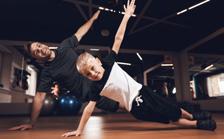

The
Unveiling the evolution of the yoga journey with asana and
Insights


We all need to get dinner on the table – every day. Want more ideas? Visit cdnbeef.ca or scan the QR code above.
Cdnbeef.ca takes you to the Canadian Beef Information Gateway all with videos and nutrition facts. In the Diet & Wellness section, recipes are organized according to common dietary preferences and health goals, like Bone Health, Diabetes Friendly, and more. The Diet & Wellness program was developed with a committee of independent dietitians, making this an ideal resource to recommend to clients.

Cdnbeef.ca is your key to get meals that fit just what you need. Be(ef) inspired!
 cdnbeef.ca
cdnbeef.ca
cdnbeef.ca
cdnbeef.ca

What does this award represent to you?
I am deeply honoured to have been recognized by canfitpro, an esteemed organization in the fitness and wellness field. I have spent 19 years pursuing my passion for evidence-based nutrition and lifestyle strategies, teaching people how to live healthier lives. Being recognized for work that I am deeply passionate about, as well as having the opportunity to share my findings, is extremely rewarding. This award reminds me that this is impactful and important work.
How did you evolve your practice and become specialized in holistic health and nutrition?
My career began in health care, where I was overwhelmed by the sheer number of conditions I encountered, many of which were preventable. I decided to leave health care with the personal goal of teaching people how to avoid preventable diseases. During this journey, I discovered holistic nutrition, and for the past 19 years, I have dedicated myself to working with clients and teaching holistic health principles as a nutritionist.
What is the biggest mistake you have made and how have you learned from it?
Well, when you have been in business for as long as I have, there are usually a lot of mistakes to learn from. One of my guiding principles is, “I am not learning or growing if it is easy.” Reflecting on the biggest mistake I have made, and possibly still struggle with, is being impatient with the results I wanted in my business and comparing my success to that of others.
I have come to realize that a strong and stable business requires deep roots to thrive. Sometimes it takes time to build the skills and a solid foundation for a stable and profitable business. I had to accept that my journey was unique, and I needed to believe that I was taking the right steps to assist as many people as possible.
Looking back, I can see significant progress from when it felt like I was just spinning my wheels. Nobody enjoys feeling stuck, but a willingness to keep moving forward will lead you to amazing places. Just keep moving forward.
As a nutritionist, what advice can you give fitness professionals looking to specialize and grow their careers in the health and wellness space?
I absolutely love this question! The
best advice I can give to any fitness professional looking to specialize and advance their career is to focus on what truly inspires them. Forget about what other people are doing or what industry leaders advise you to do. Get rooted in your passions. Determine what specializations you will require and consider how to elevate your service to a higher level.
I consider myself extremely fortunate to have a career that makes me want to get up every day, and it is all because I have consistently focused on what I was inspired to do. If you pursue your passions and structure your business around serving others, I am confident that you will achieve incredible success!
What is one of your favourite quotes that inspires you the most?
“Love is patient, love is kind, it isn’t jealous, it doesn’t brag, it isn’t arrogant, it isn’t rude, it doesn’t seek its own advantage, it isn’t irritable, it doesn’t keep a record of complaints, it isn’t happy with injustice, but it is happy with the truth.” 1 Corinthians 13:4-6
AlisaHerriman.com
IG: Alisa Herriman
FB: Alisa Herriman
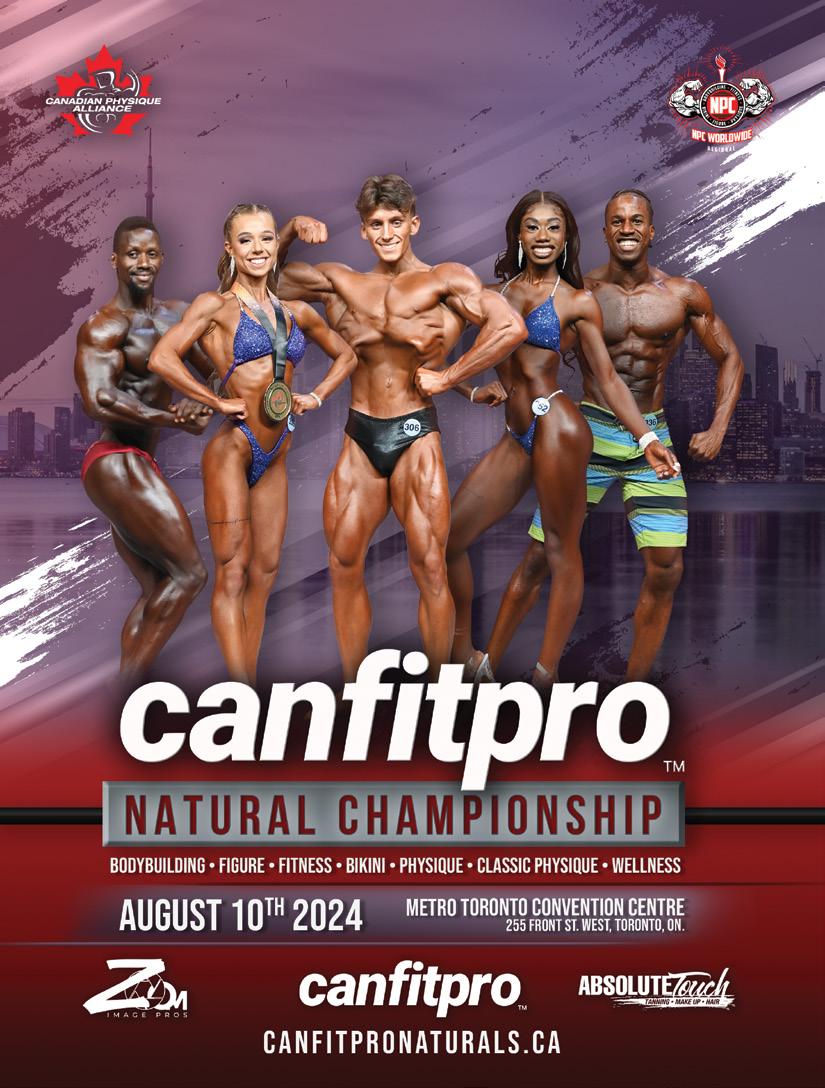

Tell us about your fitness career journey.
My fitness journey started when I was eight years old! I grew up as a competitive synchronized swimmer and loved it. Upon retiring from the sport at age 18, I stayed involved as a synchronized swimming coach, which I continue to do to this day.
As I transitioned out of elite sport, I had to learn how to work out on my own. For 10 years, I had always been with a team, having workouts developed for me by a coach, so there was a learning curve going from an athlete to an exerciser. I tried my first spin class in university and fell in love. I slowly figured out my workout groove and really started enjoying the gym.
I continued to enjoy group fitness classes after graduating university and starting a desk job and decided to become an instructor. I took my first instructor training, BodyCombat, and
my Fitness Instructor Specialist (FIS) in 2007. I told myself that if I did not like teaching, I did not have to do it, but why not try?
Well, that decision changed my life! I LOVED it. I am an introvert, but when I am on stage teaching it is like my inner self can shine. Teaching classes very quickly became the best part of my day. I continued to take different trainings and worked at different gyms in many different areas and disciplines. Teaching classes became my passion!
In 2019 I decided to take the leap. I had worked at a desk job for 14 years and was teaching fitness on the side. I knew that I wanted to be my own boss and run my own fitness business. I had a background in coaching, an undergraduate degree in Kinesiology, a Master’s degree in Exercise Psychology, and a passion for teaching fitness. All the pieces were there, I knew what I wanted to
do!
I took my Personal Training Specialist (PTS) to expand my expertise and in 2019 I started Best You Fitness as an online fitness business. Little did I know that the world was going to shut down one year later. When the entire world went virtual, I was already one year into my online fitness business. I had the infrastructure in place and my business exploded.
Since launching my business, I have learned and evolved a lot. Going into it I knew a lot about fitness, but I did not know how to run an actual business. So, it was particularly important for me to learn the skills of running a business and I found coaches and mentors who helped me.
The last four years has been the most stressful and rewarding years of my life.The connections I have made with other business owners and clients has been life changing. What started out
as a dream and a vision has turned into one of my life’s greatest purposes and joys.
Where would you like your career path to take you?
I can very easily provide my one-year goal and have a fairly good idea of my five-year goal but coming up with a 10year goal is challenging. I just cannot wrap my brain around where I will be in 10 years. And that is ok!
What I do know is that I have a passion for mental health, the connection between fitness and psychology, and I love empowering people, particularly women. I am excited to see how many more lives I can touch and where this incredible journey will take me in 10 years.
What types of transformations have you made in the last year and how has it changed you as a fitness professional or your fitness business?
I have stopped taking things so personally. When I first started out, I would beat myself up if people stopped coming to my classes, or if a client left my business. I would ask myself “what did I do wrong?”
Now I know that there are important questions to ask if a client leaves, such as, “is there something that client was missing from their experience?” It usually is not something I have done wrong.
One of my business coaches
reminded me that every moment I spend worrying about the person that has left takes me away from supporting the people that are still there. I learn from each client departure, but I ensure that I am spending most of my time supporting those that are in front of me.
What is the best piece of advice you have ever received?
I am going to share two:
1. Stay in your own lane. We can so easily get distracted by what others are doing or the latest trend. It is important to be aware, but you cannot let it distract you from your goals and journey.
2. Your best is enough. I was taking a yoga class when an instructor said this, and it has stuck with me. I use it all the time with my clients and even have it framed in my office. If you are always striving to do your best, but sometimes fall short of what you expect, be empathetic with yourself. Remind yourself that your best IS enough. If you are truly putting your best effort forward, that is enough.
Now that you have reached this point in your career, what piece of advice would you give your younger self?
Do what you love. It took me 15 years to finally do what I love. Is it easy… nope! But it makes the tough stuff easier to work through when you love what you are doing.
The caveat to this is that sometimes we are not ready to hear advice from others. There are many things I would have loved to tell my younger self, but theywould not have mattered if I was not ready to hear them.
Reflecting at this point, I would not change my journey; everything I have done and learned has gotten me to where I am right now.
Why did you decide to nominate yourself for the Fitness Professional of the Year Award?
The fitness industry is an amazing industry to be a part of, but it is also a tough one to be competitive in. It takes a lot of work to grow a successful AND sustainable business.
I want others to succeed. Nominating myself provides me with the opportunity to make that happen. If hearing part of my journey empowers or encourages someone else, then that makes me happy.
Remember, if you are starting out, do not compare yourself to people who are winning awards or generating tons of clients or income. Realize that it took a lot of time and a ton of work for them to get to that point. You will get there too. There are many highs, but there are just as many (if not more) lows that you might not get to see others go through.
Reach out for help when you need it and just keep going.


canfitpro is looking for industry leaders and educators to join our team and certify the next generation of fitness professionals.
Why Become a PRO TRAINER:
☑ You are passionate about health and fitness and want to share that passion by educating others.
☑ You are an experienced fitness professional and it’s time to take the next step in your career.
☑ You want to mentor others and ensure a strong legacy for our industry.
•
•
•
•
•
•
•




Having now been a PRO TRAINER for 14 years, I love how my business allows me to continue to follow my passion to educate and mentor new fitness professionals, helping them not only navigate the certification process from start to finish but then to also work with gyms to find the perfect employment match or help fitness professionals in their entrepreneurial endeavours as they start their own business.
For fitness professionals looking for the next step in their careers, becoming a canfitpro PRO TRAINER allows you to build a business using your passion to help others. As a PRO TRAINER, you create a legacy by delivering canfitpro’s quality fitness education and certifications within your local community and online.
Being a canfitpro PRO TRAINER is an honour. Being able to instill the passion that I have for helping people and sharing the privilege we have to change people’s lives is a responsibility I do not take lightly. It is my purpose.
It compliments my career extremely well because it allows me to not only have an impact on new trainers, but also allows me to spend time with people and find out if they are a good fit for my team.
If you have experience in the fitness industry, and want to impact people through your work, becoming a PRO TRAINER is not only a rewarding experience, but inspiring the next generation of trainers is a calling that has a massive ripple effect on the industry and the people we serve.
Since becoming a canfitpro PRO TRAINER, I have come to realize how important my role is to people. This has driven me to a level of commitment I cannot explain. For the last four years, I have met so many incredible students whose feedback has opened my eyes to the experience I am providing. I am proud of my role and honoured I can be on such a talented team of people that do the same. I also really enjoy just how fun these courses are. I have such an enjoyable time meeting new people, learning more about them, and watching as everyone’s confidence grows throughout the weekend.
I love my job!
 Nicky Coyne Richmond Hill/Thornhill/ Aurora/Newmarket/Ottawa, ON
Gina Vucetic Owen Sound/Hamilton/ Toronto, ON PTS
Nicky Coyne Richmond Hill/Thornhill/ Aurora/Newmarket/Ottawa, ON
Gina Vucetic Owen Sound/Hamilton/ Toronto, ON PTS

A TEACHER OF A SEVENTHGRADE LANGUAGE ARTS CLASS IN THE UNITED STATES INFORMED THE CLASS THAT THEY WOULD HAVE A POTLUCK THE FOLLOWING WEEK.
The teacher invited all students to bring their favorite traditional foods to share with their classmates. The students excitedly detailed their favourite food dishes and how their families prepared them. They immediately picked up on common ingredients, in particular, the different ways rice is prepared in different cultures. The following week, the classroom was filled with various dishes of flavors, colors, aromas, and tastes. It was one of the happiest and most memorable days for that class. The students were trying foods prepared in different ways and enjoying new and familiar flavors.
A company manager told the team that the next meeting would be a potluck. An employee immediately asked if it could be a “healthy” potluck, recommending everyone bring healthy food options. The manager scanned the room and noticed mixed responses to the
recommendation. Some verbally expressed doubts and challenges with “healthy” food recipes or that the word “healthy” made cooking or sharing food less enjoyable. At the potluck, salads and moderately flavored chicken were the primary options. Most people took small portions and barely ate anything. Everyone left hungry.
Food is an integral part of culture and ethnicity. Cultural foods–also known as traditional cuisines–vary across diverse communities and ethnic groups, rich in traditions, heritage, history, and personal identity. Cultural foods touch and feed the soul. It is social and spiritual while providing wholesome nourishment that contributes to overall health and well-being.
Deep rooted in culture, ethnicity, religion, social class, and economical impact are Black American Soul Food–birthed from culture and traditions reaching beyond the Atlantic slave trade, Mexican Food – food and cooking influences traced back to the Mayan and Aztecs, Chinese Food – one of the
oldest cuisines in the whole world, and Indian Food–that has a history of influences and international relationships. One of the most effective ways to learn more about these foods’ rich history and origins is to engage in healthy dialogue with people whose personal identities are shaped by them.
Healthy eating is the concept of consuming safe and nutritious foods that promote and maintain health and well-being and make you feel good and have energy. Healthy eating looks different for everyone, especially cross-culturally. Healthy eating should and can be satisfying. Healthy eating can bring you comfort, joy, and fulfillment.
Nutritional guidelines from reputable health organizations like MyPlate, created by the U.S. Department of Agriculture (USDA), Canada’s Food Guide, and Food-Based Dietary Guidelines (South Africa) all emphasize vegetables and fruits, whole grains, and a variety of protein

foods for healthy eating. These are basic standards and a broad base of various food ingredient options commonly used in multiple cultural dishes. These are loose recommendations from various food groups that are scalable with some consideration of food access, different ways of preparing food, personal health goals, and specific health conditions. Discussing food links to health concerns, such as excess weight and chronic diseases, gentle use of sugar, fats, and salts, alternative ingredients, and moderate consumption are suggested.
Yet, there is a disconnect with mainstream marketing on healthy eating, which typically depicts a bed of leaves and a highly priced fish and lacks cultural representation, but encourages elimination, restrictions, and narrowing of food choices and perspectives. This “healthy eating” notion often lacks inclusion, diversity, and recognition of cultural palates. It is necessary to redefine healthy eating, unlearn the monolithic approach, and evaluate the significance of culture and food. Accepting that current notion conforms to an unattainable and
unrealistic version of health, adding moral judgment, biases, and classism to food and health.
Healthy eating should not represent levels of morality, intelligence, beauty, or wealth. Labeling foods with negative connotations and terms like “good” and “bad,” “indulgence,” and “cheat meals” creates unconscious attitudes, shame, and guilt towards food, which is unfair, especially when some people are at a disadvantage in access and do not have a choice. Instead, viewing food with a point of respect opens the opportunity to learn about the cultural impact of food and health.
Cultural foods pack various nutritional values and health benefits. It is essential to exercise cultural consciousness in how we form our own opinions on dietary health—remembering that food can be representative of one’s identity, heritage, familial connections, history, and happiness. Healthy eating should encompass all of these things
as well as nourishment, satiety, and accessibility. Cultural foods are made with love, heart, and soul to nourish and sustain bodies. They are holistically and inherently healthy from how they are prepared, served, shared, consumed, and passed on to the next generations. Cultural foods are suitable for the mind, body, and soul.

Kia Williams, M.B.A., M.S., 200hr RYT, is the Wellness Chairwoman for the NAACP Fort WorthTarrant County Chapter and an executive board member of Fit4Mom and for Jeremiah 33:6, a not-for-profit holistic health education and preventative medicine corporation. Most notably, Kia Williams is the youngest and first black person to be awarded with the IDEA World Instructor of the Year award. Kia’s career mission is to support people who are affected by marginalization in jobs, education, healthcare, and lack of representation in the fitness industry.

Opening Ceremonies: Hamza Khan


Personal Training
Group Fitness

Active Aging
Nutrition
Business Medical Fitness
Wellness
Cycling Mind-Body Technology
5 panels



+160 presenters



















Martin Rooney Founder of Training For Warriors

Todd Durkin M.A. - Founder of Fitness Quest 10

Kia Williams MBA, MS, RYT 200

George Foreman III Founder of EverybodyFights




Andrew Coates Co-founder of The Evolve Canadian Strength Symposium Conference
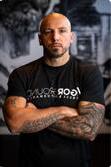
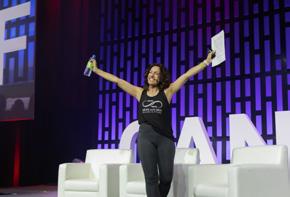

Luka Hocevar (online) Founder and co-owner of Vigor Ground Fitness and Performance Gym
Lee Boyce Strength coach and educator

Melody Schoenfeld CSCS, MA/health psychology
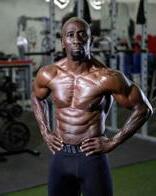
Funk Roberts
Owner of Funk Roberts Fitness and the Over 40 Alpha Brotherhood

Creator and founder of JOGA
Jennifer Hamilton CEO, Oxygen Yoga & Fitness



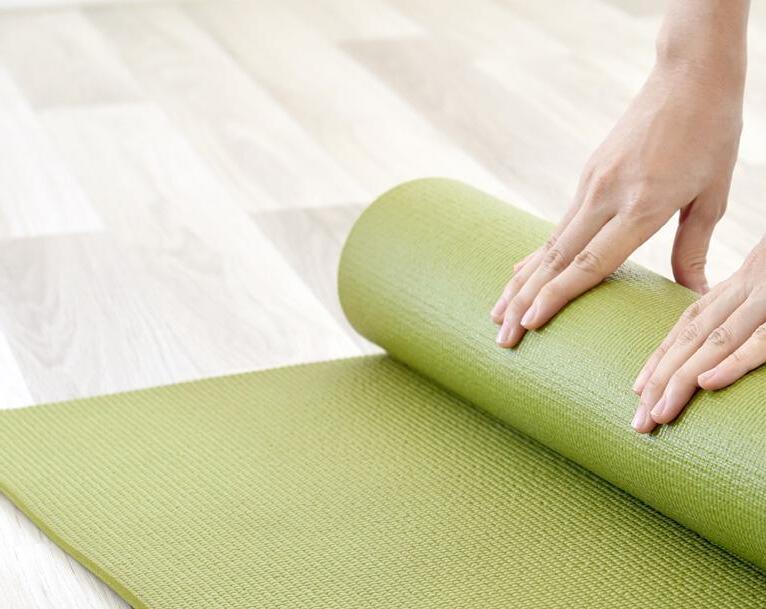
The fitness industry, while promoting health and well-being for people, is not always as well-intentioned for the planet’s health. It consumes substantial energy, uses a wide range of materials and equipment during construction and regularly burns through gallons upon gallons of cleaning products and toiletries.
When Earth Month rolls around every May, it is a timely reminder for gyms and fitness studios to take a closer look at their eco footprints and make meaningful changes where they can contribute to a better tomorrow—not just for a day or a month—but all year long.
Here is a helpful guide on how new
or established fitness facilities can go green, whether on a small business budget or part of a larger chain with more spending power.
When constructing new fitness facilities, it is crucial to prioritize sustainability from the outset. We spoke to Matt Morley, founder of Biofit, a consultancy agency specializing in sustainable interior design for hotel gyms, yoga studios, and indoor sports centres for residential developments.
When asked what aspects of sustainability fitness entrepreneurs should focus on, Morley says, “I’m
more interested in the kind of energy being used in the manufacturing process than I am in trying to pump minimal amounts of energy back onto the grid through a gym user’s pedalling power. We have to be aware of gimmicks and greenwashing to focus on where maximum impact can be made. The main areas we can impact from a sustainability perspective are around the gym flooring—such as healthy, sustainably sourced low-VOC solutions and wall finishes such as non-toxic mineral paints.”
When it comes to flooring, Morley says, “Choose a sustainable gym flooring solution that will provide

product declarations explaining what’s inside each tile or roll. That kind of transparency is key to avoiding some of the cheaper quality rubber mixes held together by potentially toxic adhesives.”
Another consideration is the vast amount of water and lighting being used. Morley says, “Consider installing low-flow taps and showerheads for water efficiency, motion sensors as well as energysaving LED lights, and of course switching to a green energy provider from the grid as a priority.”
According to the Canada Green Building Council, LEED-certified
buildings have reported 34% lower CO2 emissions and 25% less energy consumption than non-certified buildings.
... SUSTAINABILITY EXTENDS BEYOND MATERIALS TO ETHICAL PRODUCTION AND LONG-TERM ENVIRONMENTAL COMMITMENT ...
Once your facility is thoughtfully laid out, it is time to consider the equipment’s sustainability. Fortunately, several sustainable
manufacturers are available now and can be discovered quickly with some online research.
Sustainable gym equipment prioritizes eco-friendly materials like recycled rubber, minimizes production carbon footprint through local manufacturing, and considers end-of-life practices. If your gym or studio requires yoga mats, make sure they are made from non-toxic and sustainable materials.
Overall, sustainability extends beyond materials to ethical production and long-term environmental commitment so be sure to do your research and inquire with companies about how
their materials may or may not be sustainable before you invest.
Suppose you are already established but want to do more to make your gym or studio green. In that case, several actionable steps can be taken, such as implementing recycling bins and banning single-use plastics. For example, research by the Green Sports Alliance showed that recycling programs in sports venues resulted in an impressive 54% average waste reduction and a 32% reduction in greenhouse gas emissions linked to waste.
Going paperless and utilizing refillable products in washrooms, changerooms, and cleaning supplies also goes a long way toward reducing waste and saving on costs associated with disposable products.
Transitioning to washable cloths instead of disposable paper products and wipes for cleaning can also have a substantial impact.
Adopting eco-friendly cleaning products and switching to environmentally conscious toiletries are more accessible ways to build a sustainable gym environment.
“Many cleaning products rely on harmful, toxic chemicals. It’s completely unnecessary nowadays, and a high-quality, third-party-certified cleaning product will do the job just as well. It’s simply a change in mindset,” says Morley.
Going paperless is yet another way to do your part. “Green practices in day-to-day operations include efforts to minimize the use of paper by switching to digital communication and record-keeping, thereby reducing waste and deforestation.”
Finally, encouraging members to use refillable water bottles, providing
water refill stations—and choosing not to sell beverages packaged in single-use plastic—reduces plastic waste and promotes a healthier lifestyle among gym-goers.
... EARTH MONTH ... IS A TIMELY REMINDER FOR GYMS AND FITNESS STUDIOS TO TAKE A CLOSER LOOK AT THEIR ECO FOOTPRINTS ...
On a large scale, gym chain Life Time, with more than 160 locations across the US and Canada, has significantly invested in energy-efficient building materials, systems, and technologies to reduce its carbon footprint.
“Many of the gyms in their network are equipped with energy-efficient LED lighting, solar panels, air conditioning, and advanced HVAC systems that minimize energy consumption,” Morley explains. “The brand has also focused on water conservation by installing lowflow fixtures and utilizing rainwater harvesting techniques.
Despite the substantial investments made by a corporate giant like Life Time, planning to wrap up its fiveyear sustainability plan by 2026, that does not mean you cannot make a meaningful impact if you are an independent, small business owner looking to become more eco-friendly.
As a small gym or studio owner, you can make plenty of powerful changes. Gym floors eventually wear down and need to be replaced, presenting an opportunity to source more sustainable flooring. Lighting will need to be replaced at some point, too, and you can add sensors at any time to save on electricity.
Going green with cleaning and toiletry products is the easiest
change you can immediately make. These are all relatively low-lift changes you can make any time within a reasonable budget.
With gyms and fitness studios contributing to waste and energy consumption, Earth Month is the perfect call to action to reassess and transform eco footprints.
Morley, the visionary behind Biofit, advocates a holistic approach to sustainability, emphasizing the importance of conscious choices from the initial construction to dayto-day operations, whether you are a big box chain or an independently owned boutique studio.
As he wisely puts it, “Deliver on the promise of sustainability first, then communicate successes. Sustainability should be part of good business practices, not just marketing strategies.”
Regardless of size or budget constraints, each fitness facility has the power to make meaningful changes, and this journey toward a greener future starts with a mindset shift and a commitment to responsible practices.

Alicia Tyler is a journalist and editor specializing in health, nutrition, fitness, and wellness. She was previously the Editorial Director of Clean Eating and Vegetarian Times. Her work has also appeared in MindBodyGreen, MoneySense, Yoga Journal, Women’s Running, and Oxygen.
In addition to being a content creator, she’s an F45 studio owner in Toronto and a certified nutritionist and personal trainer. Read more at aliciamtyler.com

Since 2006, NPE has helped over 53,000+
businesses in 96+ countries grow to the next level, and is responsible for driving over $1.1 billion in client revenue.
NPE has been featured 8x on the Inc 500/5000 list of fastest growing companies, and has a global team based in the USA, Canada, UK, and Australia.
Recognized As:
Defines what success looks like for you... and why that matters most
Differentiates your business from the competition (so prospects would be fools to do business with anyone but you!)
Keeps yourself focused without getting off-track or overwhelmed
This PDF and short video provides valuable tips to help you create your 1-page business plan. It’s a powerful tool to keep you focused


















As fitness professionals and club owners, we are constantly striving to enhance our services and provide the best experiences for our clients. Sometimes, this means exploring new fitness trends or upgrading equipment. But have you ever considered embracing an entirely new audience: children and youth?
Before you shake your head and turn the page, let us debunk a common misconception about children in adult settings: that kids are chaotic.
I get it, I used to feel the same way. Like you, whenever anyone mentioned the idea of children in a fitness club, I would immediately
imagine tiny bodies climbing machines or hear the loud sounds of commotion coming from the change rooms.
But the truth is that quality children’s fitness programming can be an effective and profitable aspect of your boutique fitness business, when implemented properly.
In this article I will share with you the ways that children’s programming can boost your business. Plus, I will share three key factors to successfully roll out kids’ fitness programs at your facility.
Kids’ fitness is a rapidly growing
industry. Not only does offering children’s programming attract parents who are already invested in their own health, but it also creates a thriving community and offers an exciting opportunity for you to grow your business:
When members (who happen to be parents) visit your fitness center, they already value your services, so why not extend that value to their families? By offering children’s programming, you not only cater to your existing members but can also attract new adult members. Imagine the influx of traffic as parents come to drop off their children and end up

joining a personal training session or becoming a member themselves.
If you are an owner of a fitness business that has a physical location, occupancy and usage are crucial. To make the most of “off-peak” hours, let me introduce you to “peak parenting” hours: weekdays 10:00 a.m. - 4:00 p.m. and weekends 9:00 a.m. - 5:00 p.m.
Maximize your unused spaces during these times, when parents are searching for things to do with their little ones. During the week, offer “Mom and Baby” or “Early Years” programs, and on weekends “Parent
and Child” or “Family Fitness” classes can not only increase traffic but also provide a valuable service that keeps families engaged and active.
Building a Strong Community Incorporating children’s fitness programs into your studio is more than just expanding your business. It is about creating a vibrant community where families feel connected and supported. By opening your doors to families, you foster a sense of belonging and provide seamless service to keep them coming back for more.
Excited to explore this opportunity?
Here are three tips to ensure your success when bringing kids’ fitness to your boutique gym or fitness club (and avoid the chaotic scenes mentioned earlier).
The most important word you will learn when it comes to setting up kids’ fitness programs is Structure. Having a clearly defined process for how children enter and exit the facility, designated areas that children can access, and behavior expectations during programming, are crucial for organization, group management, member experience, and smooth operations.
Safety considerations encompass not only the physical aspects (studio or space, type of equipment used, type of games/activities taught) and the legal aspects (policies, insurance), but also the social and emotional well-being of children in programs. By ensuring that ageappropriate coaching techniques are always used with younger age groups, you can create supportive environments that foster positive experiences and nurture lifelong learners.
Lastly, it is imperative that all staff delivering children’s programming hold a current Certification in children’s fitness. The skills required to set-up, manage, and maintain
a quality children’s program are specific, measurable, and insurable. Reputable organizations like canfitpro, PL3Y™, and HIGH FIVE® offer world-leading training and certification courses tailored specifically for children’s fitness leaders. With a passionate team equipped with proper training and protocols, you can ensure a safe and enjoyable experience for all members, staff, parents, and children alike as you grow your business and community impact.
Bonus! Make launching even easier with a pre-packaged kids fitness program! Did you know that there are many varieties of programs you can bring to families at your venue? From dance, yoga, music, gymnastics, ninja, fitness, and multi-sport programs, pre-packaged kids’ fitness programs give you access to premade branding, expert programming, and reduced planning and research time for you and your staff.
Incorporating kids’ fitness into your boutique business can be a winwin move. Not only is it a powerful opportunity to attract new clients, boost your bottom line and foster a vibrant community, but it also makes a positive impact on the health and happiness of future generations.
Learn more about kids’ fitness, certification courses, insurance, equipment, and how to use these new offers to build your business. Visit pl3yinc.com/canfitpro

Melanie Levenberg, M.Ed., Kids Fitness Expert, International Speaker, Author, TEDx Presenter, PRO Trainer and canfitpro 2022 Fitness Professional of the Year. As the Founder of PL3Y International, her programs have gained global accolades for boosting mental health and getting over 4.1 million students in schools worldwide active through dance, yoga, and play. She coaches fitness professionals how to grow their business with kids’ fitness offers.
NPE FOUNDER & CEO, SEAN GREELEY, SHARES THE MOST IMPORTANT STEPS TO TAKE IF YOUR BUSINESS IS STRUGGLING
By Sean Greeley
Over the last 17 years, we have helped over 53,000 fitness entrepreneurs go from broke to stacking cash.
Business is not easy.
But it is simple.
And it turns out, you can break the whole journey of growing a business into a step-by-step process.
I have personally grown multiple seven and eight-figure businesses, and helped our clients generate over $1B in revenue in the last couple
decades.
Here is exactly what I would do in 2024 if my business was struggling:
1: Block 10-20 hours per week to work ON my business.
This is different from operating my business. I want to give myself the time and space to assess what is working, what is not, and have the opportunity to make adjustments.
2: Review and update a SWOT analysis.
This is foundational. SWOT stands for “Strengths, Weaknesses,


Opportunities, Threats” and it is a laser specific tool to get you incredibly clear on where you need to focus in your business.
3: Create a One-Page Fitness Business plan to simplify goals, model, and vision.
Many entrepreneurs overlook this. But as Yogi Berra said, “If you don’t know where you are going, you might wind up someplace else.”
4: Review all expenses and find where you can get lean with quick wins.
We often think we need to spend
more than is necessary to get the business up and running. Your first priority is getting your first clients. Until that happens, spend the absolute minimum to conserve cashflow and energy.
5: Clarify your perfect client avatar. Pick the kind of person you want to work with and find out where they hang out. Get to know what problems they have.
6: Update value proposition. Based on your initial prospect conversations, what do you do? Practice different ways to summarize this key piece.
7: Research market and update competitor analysis.
Who else is selling in the market and what are they doing? Allow this to inspire you and guide your thinking on what is working in the marketplace.
8: Create business positioning statement.
Why should someone work with you instead of the competitor down the street?
9: Review/update revenue streams and look for Pareto principle. The Pareto Principle says that 80% of your results come from 20% of your effort. If you reverse engineer this principle into your business, where is 80% of your revenue coming from and what 20% of activities are driving that?
10: Update your menu of services. What do you charge? Are you generating a gross margin of 75% plus? If not, it is time to update your prices.
11: Review sales strategy/process/ offer.
How are you engaging prospects? What is the journey for someone to become a client?
12: Review and update your sales presentation. Are you qualifying prospects
properly? Asking the right questions? Are your client agreements sound? Review all of this.
13: Review and update your CRM. Make sure your tech stack is intuitive, simple, and is actually being used.
14: Review and update your sales pipeline management system.
15: Use #13, 14, 15 to review and update primary offer funnel. If you do not *have* an offer funnel, use this to create one.
16: Claim listings and update business info across all 30+ local search directories.
17: Start collecting (two) 5-star reviews per week.
18: Install systems to ensure all reviews are responded to within 24-hours.
19: Niche down to one social platform that is most likely to be where your avatar is hanging out.
20: Review and update your content strategy. How are you communicating with your audience? What are you saying? What is your preferred medium of content (text, audio, video)?
21: Install a production system for weekly posts (producing threeseven posts a week).
22: Review/update facility signage to increase awareness and brand. Make sure people can find your studio/gym.
23: Review and update your business networking strategy, plan, and tools.
24: Review and update your referral marketing strategy, plan, and tools.
25: Review and update your partner marketing strategy, plan, and tools.
26: If generating 15K+/month, then turn on ads to your offer funnel. Refer back to 15.
27: Build internal playbooks that streamline processes and define standards.
28: Recruit and hire A-players to increase team capacity. This is key to scaling your business.
29: Launch NPE Raise-the-Rates Campaign to achieve 70-80% gross profit margin.
30: Review/update org structure, role scorecards, role checklists to improve staff utilization and maximize revenue.
31: Block time weekly to invest in developing leaders.
32: Review and update proforma and budget to hit your financial goals.
33: Recapitalize and restructure debt if needed.
These steps have been proven thousands of times with our clients across the world.
This may seem overwhelming.
If that is the case, head over to npefitness.com/cfp-score and access the NPE Fitness Business scorecard to get a personalized plan for growth.
Seize the day!

Sean Greeley, Founder & CEO of NPE has helped 53,000 fitness entrepreneurs go from broke to stacking cash over the last 17 years. Under his leadership, NPE has become the go-to destination for business growth systems, tools, and coaching for fitness entrepreneurs to grow to 6-, 7-, and 8-figures. To get your personalized plan for growth, visit npefitness.com/cfp-score

There are few who would argue that we need to invest in preventative healthcare.
In the face of rising healthcare costs and an increasingly sedentary Canadian population, the case for preventative exercise has never been stronger. We have the opportunity to not only improve the health and well-being of Canadians but also generate significant cost savings for our healthcare system - immediately, and long-term.
In a 2021 report from Deloitte and Touch, the cost-analysis of physical inactivity was revealed:
• Inactivity costs the Canadian healthcare system 5.2 billion, of which $3.6 billion is borne by the public health system
• Productivity loss due to a lack of sufficient activity was valued at CND $10.5 billion
• An investment of $2000 in helping

an inactive person become active results in a payback period of less than one year.
Despite the overwhelming evidence of its benefits, access to exercise remains a challenge for many Canadians, particularly those from low-income or marginalized communities. A 2021 survey, conducted by Fitness Industry Council of Canada (FIC), found that one in three Canadians say cost is a barrier when it comes to establishing an
exercise habit, and 59% of Canadians believe that gym memberships should be considered a medical expense on their taxes, a budget proposal from FIC.
By investing in subsidized gym memberships, community-based exercise programs, and healthier infrastructure, we could improve the health and well-being of all Canadians and alleviate the economic burden of chronic illness. We explore the case study of seniors to see the cost benefits of exercise prevention.
The number of Canadians over the age of 75 is expected to grow significantly in the next 20 years. We have the potential to make those last few years not only about how long we live but how well we live. Baby boomers represent almost a quarter of the population in Canada, and healthcare spending for the Canadian senior population is expected to more than double between 2011 and 2026.
Are we doing all we can to mitigate the rising healthcare costs?
Falls are the leading cause of injury-related hospitalizations among Canadian seniors, and falls can lead to reduced mobility, increased healthcare costs, loss of independence, isolation, mental health decline, and even earlier death. As the Canadian population ages, it is vital we prioritize maintaining good health, strong bodies, and independence.
According to Statistics Canada, approximately 20-30% of seniors experience one or more falls each year, leading to significant healthcare costs and a decline in quality of life. A meta-analysis published in the Canadian Medical Association Journal (CMAJ) compiled data from multiple randomized controlled trials and found that exercise programs tailored for older adults significantly
decreased the rate of falls by up to 32%.
The Canadian Chronic Disease Surveillance System estimated that 6.3 million adults aged 65 or older were living with chronic health conditions. Four chronic health conditions - cancer, cardiovascular disease, diabetes, and chronic respiratory diseases - account for over 60% of all deaths in Canada. The onset of these diseases can be dramatically lowered by lifestyle changes, and increasing physical activity is one of the most powerful tools we have in health prevention.
What if seniors were given a $500 Physical Activity Tax Credit towards gym memberships, personal training, or fitness classes? Exercise intervention is a cost-effective strategy that will have long-term benefits, one of the most compelling being a dramatic reduction in healthcare costs.
According to Statistics Canada, four out of 10 Canadians have three or more risk factors for cardiovascular disease; there were almost twice as many women aged 85 years and older diagnosed with ischemic heart disease than men of the same age. A study published in the Journal of American Geriatrics Society found that older adults who engaged in regular physical activity experienced a 29% lowered risk of developing cardiovascular diseases compared to their sedentary counterparts; rates of cardiovascular disease increase as we age - and this affects women more than men.
Research conducted by the American College of Sports Medicine highlights the cost-saving potential of exercise to manage chronic health conditions, such as osteoarthritis and osteoporosis. By improving our physical activity levels - which leads to improved function and mobilitywe can diminish the need for costly medical interventions later on, such as joint replacement surgeries, and
long-term medication use. A study, published in the Journal of Aging and Health, found that physically active seniors incurred 38% less healthcare costs.
Recently, the World Health Organization estimated that every dollar invested in physical activity interventions yields a $3-5 return in reduced healthcare costs, through curbing chronic health conditions, lower hospitalization rates, and less reliance on long-term care services.
And most importantly, we look at quality of life. Physical activity plays a pivotal role in enhancing quality of life, and particularly the ability to live independently. A systematic review published in Age and Ageing found that regular physical activity not only improves physical health but also enhances psychological well-being and cognitive function in older adults. By promoting social engagement and reducing the risk of depression and anxiety, exercise interventions contribute to a higher overall quality of life for seniors. The ability to retain autonomy is directly related to a sense of purpose and dignity.
The evidence is clear: physical activity offers a multitude of benefits that extend far beyond fitness. Through disease prevention, reduced healthcare expenditures, and enhanced quality of life and independence, an investment in improving physical activity levels for seniors will come with significant returns.

Erin Phelan is the owner of the Erin Phelan FitFam, a virtual fitness community with live group training classes. She is also the communications lead for the Fitness Industry Council of Canada.

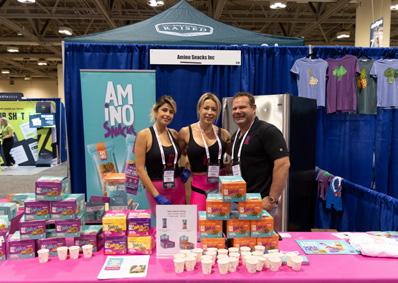

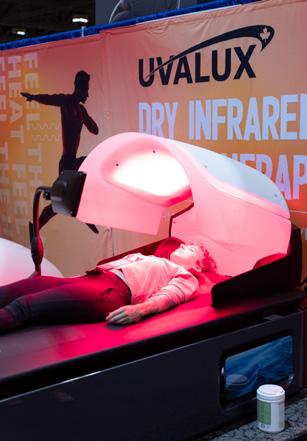
Even clients at the top of their fitness game may struggle to release the unwanted symptoms of menopause & peri-menopause. It is a journey that feels frustrating, and disappointing due to lack of knowledge.
While exercise is a KEY pillar of women’s health imagine the benefits of marrying it with understanding the science of hormone balance.
Another way to support women’s desire to reach their fitness potential with the guidance of a trainer. Hormone balance and fitness truly go hand in hand.
text: 416-884-8444 | email: kelly@avitaintegrativehealth.ca




A DIET DESIGNED TO ENHANCE COGNITIVE HEALTH AND PREVENT DEMENTIA
By Lorne Opler, M.EdIT IS THE MIDDLE OF YOUR WORKDAY AND THAT 3:00 P.M. CRASH HITS – AND SO, BEGINS YOUR AFTERNOON CONVERSATION WITH YOUR STOMACH.
You: I hear you. Stop growling at me!
Stomach: You want sugar, don’t you?
C’mon, don’t you?
You: I do. I do. I do! Sour Cream Glazed. Maple Honey Dip. Double Chocolate Peanut.
Stomach: Yes! Yes! Yes!
You: No! No! No!

Until your “No!” turns to “Yes!” and you succumb to the Strawberry Vanilla Crunch staring right at you in the display case. And so, it goes. That sugar rush that leaves you feeling temporarily satisfied but only more lethargic when you crash again.
We know sugar is bad for us. We know that excess sugar is stored as fat. We know it can increase the risk of diabetes. But what is the relation between sugar and the brain? The brain is the most energy demanding organ in our body. It gets its fuel from
glucose. In fact, 60% of the glucose broken down from carbohydrates goes straight to the brain. So, sugar is essential to fuel the brain.
Problem is, Canadians consume approximately 110 grams of sugar per day, according to Diabetes Canada. That is 26 teaspoons! And that is a problem for our brain because a growing body of evidence is showing that overconsumption of added sugar (think pop, chocolate bars, commercially prepared cakes, cookies, and donuts) can create
cognitive dysfunction. How so?
For one, it affects our “spatial memory” which refers to our brain’s ability to store and retrieve information pertaining to our environment and how to navigate in that environment. (Think about how you got to work today and remembered how to get home. That is spatial memory).
This specific type of memory originates in a part of the brain called the hippocampus. And research has shown that the Standard American Diet (S.A.D) which is high in added sugar and fat, contributes to a reduction in the volume of the hippocampus. In other words, a smaller hippocampus means reduced spatial memory.
Moreover, researchers at Wake Forest University School of Medicine in North Carolina have recently found that elevated intake of sugar (leading to higher levels of blood glucose) can prompt an accumulation of amyloid plaques in the brain. These plaques have long been associated with the risk and development of Alzheimer’s disease.
Enter the MIND Diet.
Research has shown the MIND diet can improve cognitive health and memory and reduce the risk of Alzheimer’s Disease by as much as 53% if followed appropriately.
So, what is the MIND Diet?
MIND stands for Mediterranean-DASH Intervention for Neurodegenerative Delay.
The MIND diet is a combination of two other similar and researched diets: the DASH diet and the Mediterranean diet. The DASH diet (Dietary Approach to Stop Hypertension) was developed through research to stop (or prevent) hypertension by reducing amounts of sodium which has been shown to elevate blood pressure levels. The DASH diet places a strong emphasis on fruits and vegetables, whole grains, low fat or no-fat dairy foods,
lean meats, poultry, fish, nuts, seeds, beans, and healthy fats.
The Mediterranean diet is a way of eating based on the traditional foods (and drinks) of the countries surrounding the Mediterranean Sea. It is virtually identical to the DASH diet in terms of the recommended foods to consume, but it goes one step further by encouraging lifestyle habits to complement the dietary recommendations, such as getting regular exercise and the importance of sharing meals for social interaction and positive mental health.
But researchers wanted to create a diet specifically to enhance cognitive health and prevent dementia and neither the DASH nor Mediterranean diets independently achieved those goals.
Example #1: Mediterranean and DASH diets recommend eating fruit. But fruit has not been correlated with improved brain function, except for eating berries. Therefore, the MIND diet encourages consumption of all types of berries. Blueberries are high in a plant chemical known as flavonoids, specifically anthocyanidins. The anthocyanidins make their way to the hippocampus – strengthening nerve cell connections - to improve cognitive health and reduce risk of Alzheimer’s.
Example #2: Mediterranean and DASH diets emphasize vegetables but not specifically green leafy vegetables. The MIND diet does. Why? Greens, especially spinach, collards, kale, and lettuce are positively associated with slower cognitive decline. Why is that? Leafy greens are high in Vitamin K, which research has shown boosts cognitive health. Greens are also high in folate (Vit B-9). Folate is necessary to clear the amino acid, homocysteine, from the blood. High homocysteine levels are thought to increase the risk of cognitive diseases such as Alzheimer’s.
Recommendations for the MIND diet include:
• Seven 1-cup servings of leafy green vegetables weekly.
• Five ½-cup servings of berries weekly.
• Whole grains and other vegetables daily.
• Snacking on nuts most days and eating a ½-cup of beans every other day.
• Poultry and a ½-cup serving of berries (blueberries are best) at least twice weekly.
• Fish at least once a week.
• Extra-virgin olive oil (two tablespoons daily, at different meals).
• Minimal red meat and meat products.
• Fewer than five sweets or pastries weekly.
• Consume two single-ounce servings or less of full-fat cheese weekly.
So impressive is the MIND diet, that the well-regarded American newsmagazine U.S. News and World Report placed it in the top three in its ranking of the 30 most popular diets overall in 2024. It is no coincidence that #1 and #2 on the list were the MIND diet’s progenitors - the Mediterranean diet (#1) and the DASH diet (#2).
Until more definitive treatments for Alzheimer’s Disease are developed, the best bets to protect our brain health lie in lifestyle modifications. That is why anyone concerned about healthy cognition should consider adopting the MIND diet as part of an overall strategy for better memory into our later years.

Lorne Opler, M.Ed., CSCS, is an Adjunct Professor at Seneca College in Toronto, Ontario where he teaches Introductory Nutrition. He has specific interests in the areas of exercise and mental health, nutrition and mental health, fitness for older adults and people with disabilities. His freelance fitness articles appear in Muscle and Fitness magazine, ACE Fitness, and the Washington Post. Visit his website at trainerlorne.com

PROTEIN IS A CORNERSTONE OF NUTRITION, PIVOTAL FOR BUILDING AND REPAIRING MUSCLE, SUPPORTING METABOLISM, AND ENHANCING OVERALL HEALTH AND ATHLETIC PERFORMANCE.
However, amidst the ocean of information, misconceptions, and evolving research, it is crucial for coaches and trainers to anchor their strategies in scientific evidence. This article distills top protein truths supported by scientific research, offering practical applications and solutions for coaches and trainers to further help their client and athlete goals.
1. Daily intake is where it is at
Truth: Consistent daily protein intake is essential for muscle repair, growth, and overall health.
Scientific Support: Research indicates that distributing protein intake evenly throughout the day can enhance muscle protein synthesis (MPS) more effectively than irregular consumption patterns.
Applications and Solutions: Encourage clients to monitor their daily protein intake, ensuring it meets their individual needs based on activity level, goals, and body composition.
2. You actually need more
Truth: The standard recommendation of 0.8-1.2 grams of protein per kilogram of body weight (g/kg/bw) may be insufficient for athletes. Increased intake is necessary to maximize protein synthesis.
Scientific Support: Studies suggest that higher protein intakes, especially for athletes engaged in intense training, are beneficial for enhancing MPS and recovery.
Applications and Solutions: Advise athletes to aim for higher protein targets, potentially 1.2-2.2 g/kg/bw, depending on their training intensity and objectives.
3. Utilize 3-4 relative equal feedings throughout the day
Truth: Distributing protein intake across 3-4 meals can optimize MPS throughout the day.
Scientific Support: Regular protein feedings are shown to be more effective in sustaining elevated levels of MPS, crucial for muscle maintenance and growth.
Applications and Solutions: Plan meal schedules that include protein-rich foods at each meal, aiming for equal distribution to support continuous MPS.
4. Base meals around protein first
Truth: Prioritizing protein in meals is
fundamental for satisfying nutritional needs and supporting muscle health.
Scientific Support: Structuring meals around protein can ensure adequate intake while also potentially aiding in satiety and weight management.
Applications and Solutions: Educate clients on meal planning with a focus on protein sources, complementing carbohydrates and fats to balance energy needs.
5. Protein quality depends on source
Truth: Not all proteins are created equal. Animal sources typically offer higher biological value compared to plant-based proteins.
Scientific Support: Animal proteins generally have a complete amino acid profile and higher digestibility, essential for optimal health and muscle function.
Applications and Solutions: While encouraging diverse protein sources, emphasize the importance of including high-quality animal or supplemented plant proteins to meet amino acid requirements.
6. It protects and preserves lean muscle mass
Truth: Adequate protein intake is crucial for preserving lean muscle mass, especially in calorie-deficit conditions, for fat loss.
Scientific Support: Protein plays a key role in preventing muscle loss during weight loss or in catabolic states, underscoring its importance in dietary planning.
Applications and Solutions: Ensure clients’ diets are protein-sufficient, particularly in phases of weight reduction, to maintain muscle mass.
7. Not all protein bars are created equal
Truth: The nutritional value of protein bars can vary significantly, with some offering poor protein-to-calorie ratios.
Scientific Support: Evaluating protein bars based on their protein content relative to calories and quality of protein is essential for making informed choices.
Applications and Solutions: Teach clients to scrutinize labels, choosing bars that offer high-quality protein
Protein Truth Application for Coaches and Trainers Solution
Daily Intake Monitor clients' daily protein Plan consistent protein-rich meals
Need More Adjust intake upwards for athletes Higher protein targets based on activity
Equal Feedings Distribute protein across meals
Protein-First Meals Prioritize protein in meal planning
Protein Quality Distinguish between protein sources
Preserve Muscle Mass Ensure sufficient protein in diets
Protein Bars Evaluate protein bars critically
Plan meals with equal protein portions
Educate on protein-centric meals
Include high-quality animal and plant proteins
Plan for protein sufficiency during weight loss
Teach label reading for better choices
Satiety Use protein for appetite control Incorporate high-protein foods for satiety
Anabolic Window Flexible timing postworkout
without excessive calories.
8. Protein is highly satiating
Truth: Protein can enhance feelings of fullness, aiding in appetite control and weight management.
Scientific Support: High-protein diets are associated with increased satiety, which can help in regulating food intake and supporting weight loss efforts.
Applications and Solutions: Incorporate high-protein foods in diet plans to help clients manage hunger and maintain energy balance.
9. Post-workout protein anabolic window
Truth: The concept of an immediate post-workout anabolic window is more flexible than previously thought. The opportunity to fuel muscle recovery extends beyond the immediate postexercise period.
Scientific Support: The anabolic window for protein intake postexercise may be wider, allowing for effective nutrient timing over several hours to support recovery and growth.
Applications and Solutions: Advise flexibility in post-workout nutrition, focusing on consuming quality protein within a reasonable time after training to aid recovery.
Promote timely but flexible protein intake post-exercise
Conclusion
For coaches and trainers, navigating the complexities of protein nutrition requires both an understanding of the science and practical applications. By integrating these protein truths into dietary planning and education, you can optimize your clients’ performance, recovery, and overall health. Remember, individual needs vary, and personalization is key to achieving the best outcomes.

Jonathan Mike, PhD, CSCS*D, NSCA-CPT*D, USAW-1, NKT3 is a dynamic trailblazer in the realm of exercise science and sports performance. He has enlightened audiences with over 85 talks at dozens of prestigious and eminent fitness organizations and has published dozens of peerreviewed scientific publications. He has authored 13 influential book chapters and consults with toptier industry companies including product development and business ventures. Jonathan is a soughtafter presenter nationally and internationally.
UNDERSTANDING NATURAL HEALTH PRODUCT REGULATIONS AND HOW TO NAVIGATE THE CONFUSING SUPPLEMENT CLIMATE
By Ellie Steele
MANY OF US RECOMMEND SIMPLE NUTRITIONAL SUPPLEMENTS TO OUR CLIENTS SUCH AS WHEY PROTEIN, MULTIVITAMINS, BRANCHED-CHAIN AMINO ACIDS, CREATINE, OR SOME WHOLE-FOOD GREENS POWDERS OR JUICES, BUT DO YOU KNOW HOW TO ASSESS THE QUALITY OF THE PRODUCTS YOU ARE USING OR RECOMMENDING TO YOUR CLIENTS?
Are you aware of the vast quality differences between comparable
products that could mean a product is helpful or potentially harmful? Do you understand how supplement regulations are enforced in Canada and how that differs from products from the United States or other countries? Do you know the difference between direct-toconsumer products versus typical retail products?
A perfect storm has been brewing in the natural health product industry, creating an environment that is putting the supplement industry in Canada
in danger of irreparable damage and making it harder and harder to trust the quality of our products. New natural health products have flooded our markets, taxing our current system of regulation. Large natural health product companies are increasingly being acquired by profit-driven, multi-national corporations, and online and direct-to-consumer sales are side-stepping knowledgeable professionals such as practitioners and even well-trained health food store staff that have traditionally served as gatekeepers for the
Natural health product regulations in Canada are meant to ensure the products on the market contain what the label says they contain, do not contain ingredients that are not on the label, and that products cannot make unsubstantiated health claims. Unfortunately, enforcement is a major problem and products commonly make it to market that do not meet those standards. One industry insider describes it like this: “Health Canada regulations are like a stop sign; ethical companies that care about doing the right thing will stop whether there’s a sign or not, but the sign alone doesn’t stop unethical companies from ignoring it or finding a way to work around it.”
A PERFECT STORM HAS BEEN BREWING IN THE NATURAL HEALTH PRODUCT INDUSTRY ... MAKING IT HARDER AND HARDER TO TRUST THE QUALITY OF OUR PRODUCTS.
In the US, the FDA’s ability to enforce natural health product regulations is even more dismal. That is not to say that products from the US are not often high-quality, but much like in Canada, it is impossible to know what you are getting based on the label or the company marketing.
Direct-to-consumer lines, also known as multi-level-marketing, can be tough to gauge as well, but even if their products are decent quality, they are overpriced simply due to the marketing model in which everyone in the downstream gets a cut of the profits.
It has always been impossible to determine the quality of a supplement based on the information on the label or company marketing. Once upon a time, if you stuck to product lines found in health food stores or sold by natural health practitioners and avoided lines sold in big-box or drugstores, the odds were particularly good that a product would do what it is supposed to do and not pose any
risks to your health. Now that some of our most-trusted Canadian product lines have been acquired by large, profit-driven corporations, the odds are less in our favour than ever.
One natural health product company took it upon themselves to order and test competitors’ products purchased online to see how closely the products matched the label claims. The results are depressing. The vast majority of the products did not meet the amounts claimed on the label and a few contained NONE of the active ingredient in question. Many of these operations seem to pop up overnight and are flooding the market.
Health Canada recently held a stakeholder consultation on proposed changes to Natural Health Product regulations that has ruffled a lot of feathers. The changes would increase the fees to natural health product producers to fund increased enforcement of their industry. Going a step further, an independent investigation of the industry resulted in a recommendation for new natural health products to meet the same standards as new pharmaceuticals, although that is not being proposed now. Organizations dedicated to fighting the regulations believe that natural health products are already overregulated and see the changes as a threat to the freedom of Canadians to get access to products they rely on to be well. On the other side of the debate are ethical companies that are seeing their market being flooded with products that do not meet the arguably lax standards and they welcome enforcement of the current regulations, although many of them may feel that public health dollars should be put to better use to achieve that goal rather than pass the fees onto manufacturers and consumers. Those on both sides of the debate agree that subjecting natural health products to the same regulations as pharmaceuticals is unnecessary and would severely limit, if not destroy, the industry.
So, what is a fitness professional to
IT HAS ALWAYS BEEN IMPOSSIBLE TO DETERMINE THE QUALITY OF A SUPPLEMENT BASED ON THE INFORMATION ON THE LABEL OR COMPANY MARKETING.
do in this changing and confusing supplement climate?
• Put as much effort into finding high-quality natural health products as you put into other important purchases. After all, you are putting these products in your body!
• Ignore marketing.
• Look at the founders of the company, what is their background? How long have they been in the industry? Do they take their own products? Are they based in Canada? Avoid nameless, faceless brands.
• Contact the company and ask about their practices. How do they source their raw ingredients? Does it always come from the same supplier, or will they go wherever the raw ingredients are cheapest? Are they transparent about what is in their products? Do they test their raw ingredients themselves when they arrive at their facility to ensure quality and accuracy? Do they test their finished products and are they willing to send you those results?
• Visit a natural health practitioner and/or talk with a manager of a health food store and learn about the brands they use and trust.
Find and stick with companies that are in alignment with your own values and you will increase the odds of having success with supplements.

Ellie Steele is a Registered Holistic Nutritionist, Advanced EFT Tapping Practitioner, canfitpro PTS, and Social Service Worker with over 20 years of experience in the holistic health industry. Learn more about Ellie and her work at EvolutionWellnessCoach

IRON IS VITAL FOR A HEALTHY PREGNANCY — FOR BOTH MOTHER AND BABY.
During pregnancy, iron needs to increase 50%, and many women of childbearing age, nearly a third, are low on iron even before they conceive. Starting out with a deficit makes it harder to replenish the
body’s iron stores and meet the increased demand for this essential mineral. As a fitness pro or wellness coach, you can play a role in helping women prevent or address iron deficiency, including your clients who are pregnant or planning a pregnancy.
Many women who are low on iron do not realize it. They may attribute their
symptoms—which can include low energy, fatigue, dizziness, irritability, trouble focusing, shortness of breath, heart palpitations, anxiety disorders, poor sleep, and more—to being too busy or lack of sleep. Low energy levels can impact exercise regimes making it more difficult for pregnant women to get the full benefits of exercise for pregnancy.

Unfortunately, more than half of pregnancies are affected by low iron, and one-quarter are complicated by severe iron deficiency, according to a study of more than 44,000 pregnancies in Ontario.
How much iron do women need?
When women become pregnant, their iron needs rise by 50%, from 18 mg to
27 mg a day. (Some pregnant women may need more than 27 mg—this should be discussed with a health care provider.)
Here is why: During pregnancy, a woman’s blood volume expands by almost 50%, to provide oxygen to the baby—iron is needed to create the new red blood cells. Iron is also vital
for a child’s growth, including brain growth.
Iron is also needed during pregnancy to build up the baby’s iron stores— enough to last for six months after birth. At that point, babies must eat iron-rich solid foods. One study found that babies who did not receive enough iron in utero had lower iron
levels at nine months, increasing their risk of iron deficiency and potentially irreversible developmental delays.
Low iron during pregnancy increases the risk of:
• Premature birth
• Low birth weight
• Baby born with low iron stores
• Maternal and infant mortality
• Impaired immune function for mother and baby
• Postpartum depression
Replenishing low iron can take months, even with iron supplements. It is much better to avoid becoming irondeficient in the first place.
Eating an iron-rich diet Health Canada recommends that pregnant women follow Canada’s Food Guide and take a daily multivitamin with 16 to 20 mg of iron and 0.4 of folic acid, another nutrient that is vital for a healthy pregnancy.
When planning meals, the type and amount of dietary iron matters.
Heme iron is easily absorbed by our bodies—it is found in meat, fish, and poultry. Non-heme iron is not absorbed as well by our bodies—it is found in eggs and plant foods like spinach, lentils, tofu, and enriched pasta, cereal, and breads.
Women who are pregnant or planning to become pregnant may want to eat more foods with heme iron, especially red meat like beef, which recent research has shown is the strongest dietary predictor associated with better iron status in Canadian women.
The iron content of different foods can vary widely. Since iron is a nutrient of concern in Canada, paying attention to the top food sources—and whether they provide heme iron or non-heme iron—matters.
To find the iron content of various foods, use the Government of Canada’s Canadian Nutrient File online search tool.
5 ways to get more iron
Share these effective strategies with your clients:
• Eat iron-rich animal and plant foods daily.
• Prioritize foods with heme iron (red meat, poultry, seafood).
• Increase absorption of non-heme iron from plant foods and eggs by eating them with meat, poultry, seafood and/or foods rich in vitamin C.
• Wait an hour or two after eating before you drink tea or coffee or take calcium supplements, which can reduce iron absorption.
positioned to raise awareness of the importance of iron and increased iron needs during pregnancy.
Encourage your clients to speak to their physician if they have questions or concerns about iron levels or symptoms of low iron—especially if they are pregnant or planning to be. It may be just the nudge they need to take action.
Foods with heme iron* (well absorbed)
Mussels
Beef
Canned sardines
Herring or Atlantic mackerel fillet
Chicken or turkey (dark meat) or pork
Atlantic salmon or rainbow trout fillet
Foods with non-heme iron (less well absorbed)
Cooked pasta (enriched)
Pumpkin seeds
Fresh spinach
Eggs
Canned baked beans
Firm tofu
*Values based on cooked food.
Serving sizes based on Health Canada’s Table of Reference Amounts for Food: https://www.canada.ca/en/health-canada/services/technicaldocuments-labelling-requirements/table-reference-amounts-food.html
% DVs calculated based on Health Canada’s 2016 Nutrition Labelling – Table of Daily Values: https://www.canada.ca/en/health-canada/services/ technical-documents-labelling-requirements/table-daily-values.html
• Use cast-iron cookware. It adds a small amount of non-heme iron to foods, especially if they are moist, acidic, and cooked slowly (e.g., stew, tomato sauce).
As a fitness professional who frequently discusses health topics with your clients, you are uniquely

Carol Harrison is a registered dietician who loves her daily workouts! She has a food nutrition communications company in Toronto. For more recipes, healthy hacks, or article suggestions, connect with Carol on IG @CarolHarrison.RD


FOR PERSONAL TRAINERS, EMBRACING A HOLISTIC APPROACH HAS BECOME A PIVOTAL PART OF BEING SUCCESSFUL. WHY?
Because more and more clients now understand how it is vital for their own personal success too.
Between wearable devices on their wrists, physiotherapists on their Instagram feeds, and home cookbooks packed full of healthy recipes, there is no escaping the fact that fitness, health and wellness are all intrinsically linked.
As a result, nutrition coaching has emerged as a vital component in this holistic paradigm, acting as the linchpin that fortifies the foundation of personal training.
Personal trainers who are also able to provide nutrition coaching services can enable clients to develop healthy
and sustainable routines. But that is just the beginning! Let us take a deeper look at some of the key elements of great nutrition coaching.
#1: Assessing every client’s varying needs
Before you help someone achieve their goals, you first need to find out what these goals may be. You are likely already doing this with your clients, whether their goal is to lose weight or build muscle, now you just need to mix in nutrition goals as well — a good nutrition coach will always start by understanding what a client’s needs, goals, and challenges are.
This understanding can be gained through a thorough assessment of the client’s medical history, lifestyle, dietary habits, and preferences. This assessment allows you to establish achievable objectives and helps to build trust between you and your client. It is also a vital element of personalized nutrition planning,
which is up next.
#2: Personalized goal setting and planning
After assessing each client’s needs and goals, trainers should create a personalized nutrition plan that fits the client’s dietary preferences, requirements, and health status. This plan should be flexible and adaptable, so that it is always aligned with the client’s changing needs and goals.
Every body is different, and everybody has different objectives. So, the more tailored your nutrition recommendations are to a client’s specific needs, the higher the likelihood of success is. It is also so much easier for clients to stick to plans that closely align with their needs, desires, and daily routines.
#3: Providing education and raising awareness
The nutrition coaching process is about so much more than merely

dictating guidelines and meals. It is about empowering the client with a profound understanding of nutrition’s impact on their overall health and fitness goals.
At the end of the day, education and awareness are the pillars upon which successful and enduring transformations are built. Establishing a foundation of education not only enriches the client’s awareness, but also serves as a catalyst for informed decision-making as their journey progresses.
Continued education also nurtures a collaborative partnership between the coach and the client, fostering a sense of shared responsibility for achieving sustainable results.
#4: Regular monitoring and occasional tweaks
Keeping a keen eye on how clients are advancing enables you to gauge the efficacy of your nutrition program,
and pinpoint any necessary tweaks for optimal results. For example, a client who is progressing well in their strength training may now be lifting heavier weights — so you likely also need to revisit their daily protein intake.
Positive outcomes not only enhance adherence to the plan but also serve as a motivational force, propelling clients closer to their goals. This is ultimately what it is all about! And it is a win-win situation, as it contributes to heightened customer satisfaction, further solidifying your standing as a respected trainer.
#5: Ongoing support and motivation
Nutrition is not just about what you eat; it is a lifestyle shift. When clients have a personal trainer that provides regular support and motivation, it is a real boost for them when it comes to sticking with this lifestyle shift.
Regular check-ins and pep talks foster accountability, making it more likely for clients to stick to their nutritional goals. It is the secret sauce for longterm success, turning occasional efforts into sustainable habits.
ABC TRAINERIZE is a member engagement mobile app and software platform that allows coaches and fitness businesses to expand their reach beyond their physical space, better connect with members, and digitize the training experience. By combining fitness, nutrition, and habits with online coaching, ABC Trainerize can help coaches drive deeper behavioral changes and healthier lifestyle decisions. ABC Trainerize is available as an integrated solution with ABC platforms, as well as other third-party member management solutions.
A PERSONAL JOURNEY TOWARDS A HEALTHIER PLANET AND SOCIETY
By Yassine AitAzzi

IN THE DYNAMIC REALM OF FITNESS, WE ARE NOT JUST SCULPTING BODIES; WE ARE SHAPING LIFESTYLES, FOSTERING HOLISTIC WELLBEING, AND ADVOCATING FOR SUSTAINABLE PRACTICES THAT EXTEND BEYOND THE GYM FLOOR.
As a partner of canfitpro, Gallagher is committed to championing initiatives that promote ethical and sustainable food choices within the fitness industry.
For me, sustainability is not just a buzzword; it is a way of life. I have come to realize that the choices we make about food we consume profoundly impacts our planet’s health. By choosing locally sourced, organic, and seasonal produce, we can reduce our carbon footprint and support local farmers. It is about nourishing our bodies while also nourishing the Earth.
Ethical food choices have become a core value in my life. I believe that every living being deserves to be treated with compassion and respect. By supporting the decision to choose humanely raised and ethically sourced animal products or exploring plant-based alternatives, we can promote a more compassionate society. It is about making choices that align with our values and contribute to a better world.
1. Lead by example: Embrace sustainable and ethical food choices in your own life. Share your personal journey with your clients and inspire them to make similar choices.
2. Education: Stay informed about sustainable and ethical food practices and share this knowledge with your clients. Provide resources, articles, and workshops to help them make informed choices.
improved nutrition and reduced environmental impact.
4. Collaboration: Partner with local farmers, organic food suppliers, and sustainable food organizations to promote their products and initiatives. This not only supports local businesses but also provides your clients with access to high-quality, sustainable food options.
5. Mindful Consumption: Encourage clients to practice mindful eating by focusing on the quality and source of their food. Discuss the benefits of reducing food waste and the importance of portion control.
6. Community Engagement: Organize events, workshops, or cooking classes that promote sustainable and ethical food choices. Engage with local communities and create a network of like-minded individuals who share the same values.
Incorporating sustainability into our professional practices not only benefits the environment but also enhances our reputation as ethical and socially responsible leaders in the fitness industry. By demonstrating our commitment to sustainability, we attract like-minded clients, differentiate ourselves from competitors, and contribute to the broader movement towards a more sustainable future.
3. Menu planning: Incorporate sustainable and ethical food options into your meal plans and recipes. Highlight the benefits of these choices to your clients, such as

Yassine AitAzzi is the Marketing and Communications Manager at Gallagher in Canada, focusing on small businesses. Contact him at Yassine_AitAzzi@ajg.com or visit ajg.com/ca/canfitpro

THIS IS AN EXCERPT FROM STRENGTH TRAINING FOR FAT LOSS,
BY NICK TUMMINELLOWHEN IT COMES TO FAT LOSS, MOST FOLKS GO ON SOME SORT OF DIET. ALTHOUGH IT MAY SEEM LIKE THERE IS AN ENDLESS VARIETY OF DIETS, MOST CAN BE CLASSIFIED INTO ONE OF THE FOLLOWING FOUR TYPES:

1. Diets that drastically cut calories
2. Diets that cut fat
3. Diets that cut carbohydrate
4. Diets that cut out certain types of foods
5. For the most part, I don’t recommend any of them. Let me explain why.
Anytime someone says that the relationship between how many calories you consume per day and the number you burn per day is the single most important factor when it comes to determining whether you lose fat, someone else tries to refute it by bringing up the fact that

the quality of the calories you eat matters. They present it as an eitheror proposition, but it is not. Both quality and quantity matter.
Research into the potential advantages of diets emphasizing protein, fat, or carbohydrate has found that reducedcalorie diets result in clinically meaningful fat loss regardless of which macronutrients they emphasize (1). While the research doesn’t discount that some calories are more nutrient dense than others — we’ve all heard the term empty calories before — it demonstrates that you can be well nourished and also overfed. Food quality and food quantity are important factors that should be considered together. As important as it is to eat high-quality, nutrient-dense foods for general health, you can still gain fat from eating healthfully if you eat too many calories relative to what you’re expending.
Although it’s well-established that fat loss is determined by burning more calories each day than you consume, I’m still finding that most people don’t need to bother with counting calories if they first emphasize the quality (i.e., nutrient density) of the foods they eat over the quantity (i.e., number of calories). It spells success for most people because when you concentrate on the quality of the calories you consume, you end up taking in fewer total calories since most high-quality foods (e.g., chicken breasts, veggies) are lower in calories.
Put simply, too much fat in any form provides excess calories in the diet. However, simply cutting out all fat in your diet is not a good idea. Keep in mind that 1 gram of fat equals 9 calories, while 1 gram of protein or carbohydrate equals only 4 calories. So, if your current diet consists of 30 percent fat (or more) and you decide
to simply cut it all out, you have just eliminated a significant portion of your overall calorie intake. If you drop your calories too low, you will drastically slow your metabolism and your body will likely start to feed off your muscle tissue for the energy it’s no longer getting from the food you eat. In fact, most studies on the subject have found that the larger your caloric deficit, the more muscle you’ll lose (2-8).
When your body begins to feed off muscle tissue, it’s called a catabolic state. This is not good because, as we’ve discussed, muscle is not only metabolically active tissue—the place where fat is burned—but is also what gives you an athletic shape and keeps you strong.
FOOD QUALITY AND FOOD QUANTITY ARE IMPORTANT FACTORS THAT SHOULD BE CONSIDERED TOGETHER.
Additionally, we all know how bad we feel when we don’t eat enough and become malnourished. It becomes hard to concentrate on a simple conversation, much less perform well at work, hit it hard in the gym, or engage in sporting competitions.
To better understand why just cutting carbs is not the answer to fat loss, you must understand some basic facts about carbohydrates:
• The human body is fueled by glucose.
• Carbohydrate is more easily converted into glucose than protein or fat is, and it is the body’s preferred source of energy and the brain’s essential source of energy.
• Glucose is stored in the blood, muscles, and liver as glycogen.
• One gram of glycogen is bound to approximately 3 grams of water.
It’s no wonder why someone who cuts carbs loses so much weight so
fast—glycogen is associated with about triple its weight in water. It’s therefore likely that the person lost mostly water weight. This is why using only the scale to gauge your progress is a bad idea: The scale doesn’t know the difference between muscle weight, water weight, and so on. In other words, there’s weight loss and there’s fat loss. When people say they want to lose weight, they mean they want to lose fat.
In every fad diet there is always some specific enemy. In these diets, it is not a type of nutrient (fat, carbohydrate, etc.) that is the enemy; rather, it is a specific type of food or foods. Many of these diets take foods that a small portion of the population is allergic to, like foods containing gluten or dairy, and advise everyone to avoid them as well, which is not only scientifically unjustifiable, it’s like saying that since some people are allergic to dogs, no one should get a dog. Other diets demand that you eliminate a whole host of common foods that they claim are the “cause” of sickness and disease. Interestingly, these diets often make mutually incompatible claims as to which foods cause disease and which prevent disease.
The fact is all of these eliminationtype diets take an extreme approach to problems that can be solved with good old moderation. In short, unless you have a genuine food allergy, there’s no need for you to fully eliminate any type of food or ingredient from your diet.





With thousands of viral fitness challenges, online coaches, and fitness influencers soaring in popularity thanks to platforms such as TikTok, Instagram, and YouTube, fitness content is available to the masses now more than ever.
Due to this increased popularity and accessibility, it is essential for fitness professionals to maintain that delicate balance between generating awareness about their fitness programs and services through social media engagement, and prioritizing meaningful impact and results for the populations that they serve.
Here are a few recommendations for how fitness professionals and fitness business leaders can balance both growing impact and influence for the greatest success in a fitness operation.
The internet is saturated with fitness-related content for nearly every interest and demographic.
What distinguishes a certified fitness professional from a general fitness enthusiast is formal education and expertise. Thus, to successfully deliver both influence and impact, it is important for fitness professionals to keep quality education at the forefront of all social media communications.
Specifically, when promoting and engaging from a business-related perspective on social media, fitness professionals should seek ways to develop and empower viewers by providing them with valuable information.
When developing content, I begin by considering common issues or challenges that I observe either fitness professionals or the general population experiencing in a fitness setting.
From there, I consider the best means to educate viewers and/ or readers on how to overcome this challenge.
Sometimes, the best means to educate may be via a video, a short post, or a published blog. However, regardless of the medium I select, I make sure to keep quality and applicable educational information at the forefront.
It is easy to get inspired and influenced by viral online fitness content. While listening to and watching other creators may help to stimulate your creativity, you must not allow outside influence to stifle or deter your message.
I am a firm believer that we are most impactful when we discuss topics about which we are truly knowledgeable and passionate. Thus, I encourage all fitness professionals seeking to balance both influence and impact to stay focused on the topics and messages that consistently align with both your areas of expertise and personal interest.
Maintaining focus in this capacity will ensure clarity and strength of your message and help establish your brand.
As the old saying goes, “If you build something for everyone, it will work for no one.” The same philosophy applies when creating fitness-related content.
Therefore, to be both influential and impactful, it is important to identify your target audience prior to creating your content.

To help identify my target audience, I begin by asking myself three key questions:
1. What topic needs to be addressed?
2. Who needs to hear this most?
3. What do I want the audience to take away from this?
Once my target audience is established, I can begin developing the intended content using the appropriate medium and communication style.
For example, when my target audience is seasoned fitness professionals, I often utilize more industry-specific and scientific language that is familiar to and will resonate with this audience.
Conversely, when my intended audience is novice exercisers, I keep the topics discussed a bit broader and provide more general recommendations that can be adopted for a variety of individuals.
As fitness professionals, we are experts in our chosen field. However, showing your expertise does not always mean your content must be overly compli-
cated. For the greatest influence and impact, I recommend keeping your content as simple and concise as possible.
One of my main priorities when developing online content is for the information that I share to be both easily understood and highly applicable. To ensure this, I do my best to communicate my point in as few and as simple of terms as possible. The last thing you want to do is discourage your audience because the information you shared is too abstract for them to understand or consider.
There may come a time in your content development process when you feel as though you have run out of ideas. When inspiration is lacking, I recommend remembering why you decided to take this step in the first place.
Reflecting upon your initial motivations is often a fantastic way to reset your thought process and provide additional creativity.
My “why” is that I want to impact the next generation of fitness professionals by ensuring that quality information
and educational material are readily available.
During the times when the content ideas are not flowing as easily for me, I think back to when I was a novice fitness professional, and I consider all the things that I wish I had known earlier in my career.
Envisioning myself at this stage in life helps me to re-center and become inspired once more because I can clearly see the potential impact of the content that I am creating.

Brittany Todd is the Owner and Founder of Fluorescent Fitness, where she works to provide customized fitness and wellness training and solutions for organizations and fitness professionals.
Brittany is an accomplished presenter, a published author of a fitness book, research studies, accredited fitness educational programs, and fitness editorial content.



STRESS RESILIENCY CERTIFICATE COURSE
Equip yourself with the tools to handle stress and recharge body and mind.


This is an online program.
4 FIS 4 PTS 4 HWL CECs upon completion.

CHANCES ARE, YOU ARE FAMILIAR WITH YOGA AND CAN IMMEDIATELY BRING TO MIND WHAT A YOGA CLASS LOOKS AND SOUNDS LIKE WHEN YOU PICTURE LONG HELD STRETCHES, TAPPING INTO YOUR CHAKRAS, SITTING CROSS LEGGED IN MEDITATION, CANDLES BURNING, SOFT MUSIC PLAYING. JOGA IS NOT THAT.
Yes, both JOGA and yoga are mind and body practices, but that is where the similarities end. So what exactly makes JOGA different than yoga?
Yoga
Yoga is a mental, physical, and spiritual practice that originated in ancient India. The goal of traditional yoga was not only to become more flexible and to train the body and
mind to sit in contemplation for long periods of time - as we commonly think of yoga in the Western world today - but to discover an understanding of the connection between mind, body, and spirit. Traditional yoga is deeply rooted in this philosophy of practicing selfawareness and enlightenment.
True to its heritage and beginnings in Hinduism and Buddhism, Sanskrit, the ancient language of South Asia, is still used when teaching and practicing yoga today. Just like the word yoga itself, which comes from the Sanskrit ‘root’ word ‘yuj’ meaning ‘union’, most yoga terminology ties back to its foundations in these ancient schools of philosophy. Ultimately, yoga is a discipline with deep roots in achieving spiritual harmony.

JOGA
Similar to yoga, JOGA involves physical postures, breathing, and relaxation techniques. However, where the goal of yoga is to become more flexible and spiritually aware, JOGA’s aim is to enhance performance, improve concentration, and reduce recovery time within the context of an athletic environment.
Athletes do not need to be flexible, nor do they need to be able to torque and hold their bodies in bendy positions. In fact, performing many of the static type stretches found in yoga can actually do more harm than good for an athlete as they need to have tight mechanics to produce power and speed. Think of an elastic band, if you continue to stretch and pull it, it loses its elasticity and ability

to produce kinetic force. Most yoga postures are contradictory to the biomechanics of sports movements and counter intuitive to the neuromuscular patterns that an athlete has been developing for years.
Rather than flexibility, JOGA focuses on a functional kinetic chain with a balance of stability and mobility. JOGA is a three dimensional neuromuscular movement system that is designed to create neuromuscular memories that are cohesive to how an athlete moves and trains. It is not just ‘yoga for jocks’ or ‘athletic yoga’ (which are generally classes that simply modify yoga postures). Through emphasizing the kinetic chain and a combination of dynamic and static positions, JOGA addresses common muscle imbalances, overuse of joints, and exposes mobility/stability weaknesses that appear in an athlete’s specific kinetic environment.
The specific breathing and relaxation techniques in JOGA are used to support a more balanced nervous system so athletes can be better equipped to manage the high-stress demands of the job. From learning how to stay calm and non-reactive while executing plays to practicing calming the mind for better sleep
and recovery. JOGA’s breathing and relaxation techniques are coached in a way to educate an athlete on how to connect their breath to their body mechanics, thus improving self awareness and the ability to be more mindful.
If your goal is to improve overall flexibility and cultivate resiliency in both mind and body, then a consistent yoga practice is the perfect place for you/your client . But if you are an athlete or someone who needs to be moving at high speeds, lifting weights, and loading the joints, then JOGA is the perfect compliment to your programming. With JOGA, you get the physical and psychological benefits of yoga, but in a way that is individualized to your body and cohesive to the biomechanics of your sport and training regime.
Yoga provides instructions that place a focus on the breath and physical movements, like “inhale and expand the side ribs” or “lengthen your spine and lift your heart centre to the sky.” JOGA is coached with language that resonates with an athlete’s mindset; words like agility, proprioception, change of direction, etc. Every
position, movement , cue in JOGA is purposeful and designed to either enhance performance or prevent injuries. JOGA World’s mission is to be the standardization of “Yoga in Sport” so that if you are an athlete and/or coach you would look to someone who is certified in JOGA to be confident that your athletes are safe (working within their structural range of motion) and programming is cohesive to existing training protocols.
JOGA YOGA
Stability and mobility
Results based (benchmark) positions
Programs designed to augment training /rehab protocols
Flexibility and balance
Working toward a pose with awareness around breath
Classes designed for yoga studio/ culture
Performance / results based Rooted in yoga philosophy
Alignment focused around Kinetic Chain functionality
Alignment based around anatomy and chakras
Anatomy based cueing system Language based around Sanskrit
Becoming JOGA certified is a great tool in your professional toolbox regardless if it is just to improve your own understanding of your body mechanics or if you are a fitness professional looking for a program to augment your existing training services. In either case, your mind and body, and clients, will thank you!

As the creator and founder of JOGA, Jana Webb is a trainer to the best athletes in the world from the NBA, NFL, NHL, MLB, and MLS. Jana’s influence and impact are felt beyond her through the JOGA certification program. JOGA is a system that is utilized by doctors, therapist and fitness experts worldwide.

AS PERSONAL TRAINERS, IT IS OUR JOB TO TAKE OUR CLIENT’S CONCEPTUAL GOALS AND TURN THEM INTO A REALITY:
Linda doing her first pull-up since high school; Barry completing a week-long hike without ever questioning his fitness; Cathryn feeling beautiful in her wedding dress. To get these results, it is helpful to think of ourselves as craftspeople using our tools to build our client’s dreams. To get the job done safely and effectively, it is essential that we have the right tools.
For those who are setting out on their career as personal trainers, it is important to have a starter toolbox. This starter toolbox will include general assessments to cover the upper body, lower body, and core, plus the ability to coach all foundational movement patterns at an entry-level. When choosing the specific tools, think about what assessments and movements will be
accessible and useful to the greatest number of potential clients. Practically, your toolbox might look something like this:
• Basic assessments: a squat analysis, a wall slide test, and a torsion control test
• Foundational movements: a bodyweight squat, a kettlebell deadlift, a bodyweight split squat, an elevated pushup, a suspension trainer row, and an elbow plank
When it comes to performing a lower body assessment there are many options you could choose from, but my preference is a squat analysis. It can be applied to most clients, and it can give us a plethora of information about the lower body. By using our coach’s eye, we can see what our client does naturally in this movement, discern what errors may be occurring, and create a strategy as to how we can improve the movement.
As for the ability to coach foundational movement patterns, we should choose those which benefit the largest number of clients. Using the squat pattern as an example, my recommendation is to know how to coach a bodyweight squat. It is an accessible entry point for many clients and has benefits for any goal type (body composition, quality of life, or performance). Coaching the correct movement sequence, proper breathing and bracing techniques, and effective force generation will lay the foundation for progressively stronger and more advanced squat types in the future.
Once we are comfortable with the basics, have gained on-the-floor experience, and have furthered our education, it is time to add more specific assessments and advanced movements to our toolbox. Assessments will be more individualized to client goals and needs and may focus on specific
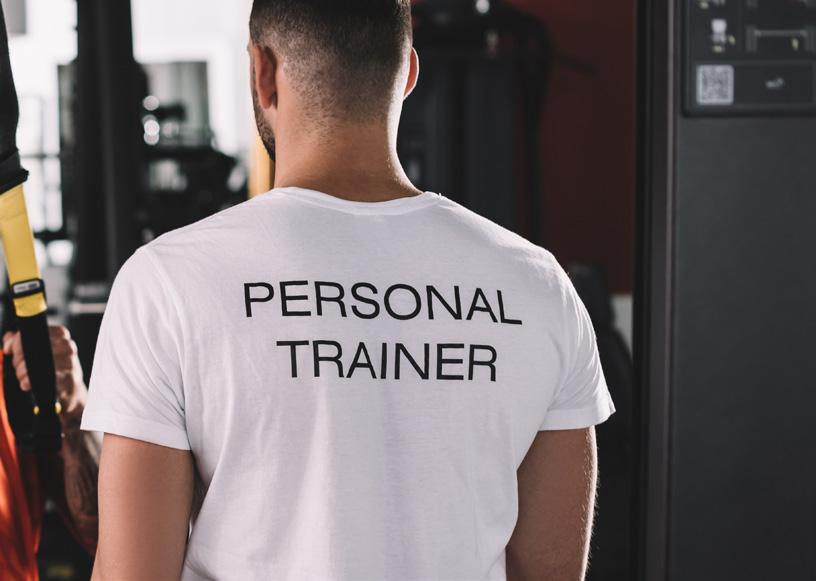
joints or biomechanics. An example for the lower body is the knee-towall test to assess ankle dorsiflexion, which would be useful for a client who wants to be able to catch a clean at full range. As for more advanced movements, these too will be chosen on a more individual basis. A client with powerlifting goals may benefit from learning a low bar back squat, whereas a client with a limited shoulder range of motion may feel more comfortable with a safety squat bar.
Of course, we cannot simply go to the local hardware store to pick up these skills for our personal trainer toolbox. Personal trainers should seek out well-respected and trusted members of our industry for advice and mentorship to expand their abilities.
Our peers are one of the greatest resources we have in the gym. If you work with another trainer who is loved by their clients and is always
delivering remarkable results, seek their guidance. You can ask them to take you through a workout, pick their brain over coffee, or get their recommendation on the best courses they have taken and books they have read.
Elsewhere, many respected professionals and organizations in our industry provide content for free through social media, blog posts, newsletters, and research reviews. Though this is not an exhaustive list, some of my personal recommendations are: DTS Fitness Education, Dean Somerset, Citizen Athletics, Dr. Alyssa Olenick, MASS Research Review, and Stronger By Science. Trusted sources will have education and experience and be regularly recommended by other professionals. More importantly, the best sources know that every client is an individual who requires a unique set of tools.
Sometimes, choosing the right tool comes down to trusting your gut. This is why personal training is both an art and a science. You can turn a screw using the tip of a knife – at best you will be inefficient; at worst you will cause injury. To be safe and effective, focus on mastering the basics first, and then keep on learning. With more knowledge, your toolbox will grow; with more experience, your ability to choose the right tool will improve.

Ryan Kideckel is a Level 5 Personal Trainer at GoodLife Fitness Kelowna, a National Trainer for GLPTI, and a Content Developer for the GoodLife App. He believes that empowering people to become the strongest version of themselves will give them the opportunity to live their most fulfilling life.
THE BENEFITS BEHIND THE FIVE MOST POPULAR PIECES OF EQUIPMENT AND THE ‘COMBINED APPROACH’ TO TRAINING
By Matrix Fitness
IN THE ERA OF STRENGTH TRAINING, YOU MIGHT FIND YOURSELF WANTING TO FOREGO CARDIO TO MAXIMIZE YOUR GAINS IN FITNESS.
But the latest research shows that it is more advantageous to have a wellbalanced blend of cardio, strength, and mobility programs for your workout plan. If 2024 is the year of strength training, look to the horizon where “combined approach” training will be all the rage.
Dr. Karlie Intlekofer, Global Wellness Researcher at Matrix Fitness, says recent studies have shown the “combined approach” of cardio and strength are ideal for capitalizing on the benefits of exercise. “Exercise is crucial for metabolic health, improving blood lipids, blood sugar, blood pressure, and reducing body fat,” writes Dr. Intlekofer. “Combined approach training is the most effective choice in improving metabolic and cardiovascular parameters.”
How do you get the most bang out of
your cardiovascular training? Matrix looks at the benefits behind the five most popular pieces of equipment: the treadmill, indoor bike, elliptical, rowing machine, and climbmill.
Treadmills are the staple product in both home and gym settings; offering a convenient way to train in a controlled setting, whether you are a walker or a runner. A treadmill user’s ability to control intensity and effort, regardless of conditions, means a continuous approach to training.
Research published in the Journal of Strength and Conditioning Research found that treadmill running can provide higher cardiovascular and metabolic responses compared to outdoor running due to the runner’s ability to easily change incline and stay consistent with pacing. The Matrix Performance Plus Treadmill sets a new standard with a shock-absorbing slat-belt and a high-efficiency drive that makes even the most intense run feel comfortable, solid, and smoothlasting up to 100,000 miles in the most intense of environments.
Where else can you imagine yourself virtually racing in the mountains and competing on a leaderboard, except on an Indoor Bike? Indoor cycling has gained immense popularity, thanks to its low-impact nature combined with the element of fun and distraction. A study published in the Journal of Sports Science & Medicine found that indoor cycling can significantly improve cardiovascular fitness and lower body strength while minimising stress on joints, making it an ideal option for individuals with joint issues or those recovering from injuries. Recumbent bikes are ergonomically refined for members of all kinds, particularly those who might have back pain.
Elliptical trainers offer a full-body workout by engaging both upper and lower body muscles in a smooth, low-impact motion. According to research published in the Journal of Strength and Conditioning Research, elliptical training can be as effective as treadmill running in improving cardiovascular fitness, while also reducing perceived exertion and impact on joints. Ellipticals are also excellent pieces of equipment for lower intensity cardiovascular training that keeps the heart rate in a stable and sustained zone and can also be beneficial for recovery after an intense strength workout. Research published in the Journal of Strength and Conditioning Research also highlighted that elliptical training at moderate to high intensities
significantly improved lower limb power, contributing to enhanced athletic performance and functional capacity.
Did you know rowing is one of the most efficient ways to get a high intensity cardiovascular workout? This is due to the fact that rowers, or ergometers, provide a comprehensive workout that targets multiple muscle groups, including the legs, core, arms, and back. A study published in the International Journal of Exercise Science found that rowing can elicit high cardiovascular responses and calorie expenditure, making it an incredible option to burn calories and improve overall fitness.
The Climbmill goes head-to-head with the treadmill as one of the most popular pieces of equipment in the gym, and one only need to look at the benefits to understand why: Even just a few short stair climbing sessions offer impressive boosts to fitness, as shown by an eight-week study in middle-aged adults. Two-minute stairclimbing sessions were initiated at just one session per day, progressing to three sessions per weekday for weeks five through eight. The stair climbing group improved their fitness levels by almost 10%, an amazing outcome considering that participants accrued less than 30 minutes of exercise per week, and this indicates that stair climbing is incredibly potent at boosting fitness levels.
When taking a combined approach to training, you want to choose the right cardio for the right workout that day - there is no one-size fits all. If it is a heavy weight session, consider a recovery workout on an elliptical. If you are feeling like training in your HIIT zone, use the rower, bike, treadmill, or climbmill to push intervals of power and intensity. A study published in the Journal of Sports Science and Medicine found that indoor cycling significantly improved VO2 max, a measure of
cardiovascular fitness, indicating enhanced oxygen uptake and utilisation by the body.

This is the timeless question. Do you do your strength training, finished by cardio, or hit the cardio and then the weights? A study published in the BMC Sports Science, Medicine and Rehab found similar benefits in terms of cardiovascular fitness, muscular strength, and endurance when testing the sequence of cardio before strength, or strength before cardio. This lack of difference suggests that the order of exercise does not play a significant role in determining the effectiveness of the workout or the subsequent physiological adaptation
But while trends will come and go, one thing is clear: Do not hate cardio! There is much to be gained from your cardiovascular training.
In 2001, Johnson Health Tech launched Matrix to bring premium fitness equipment to the marketplace. Fueled by crosscultural collaboration, today Matrix offers a complete line of cardio, strength, and group training equipment for health clubs, luxury resorts, and collegiate athletic teams, plus club-quality equipment reimagined for the home. Matrix is the proud sponsor of the Fitness Industry Council of Canada.





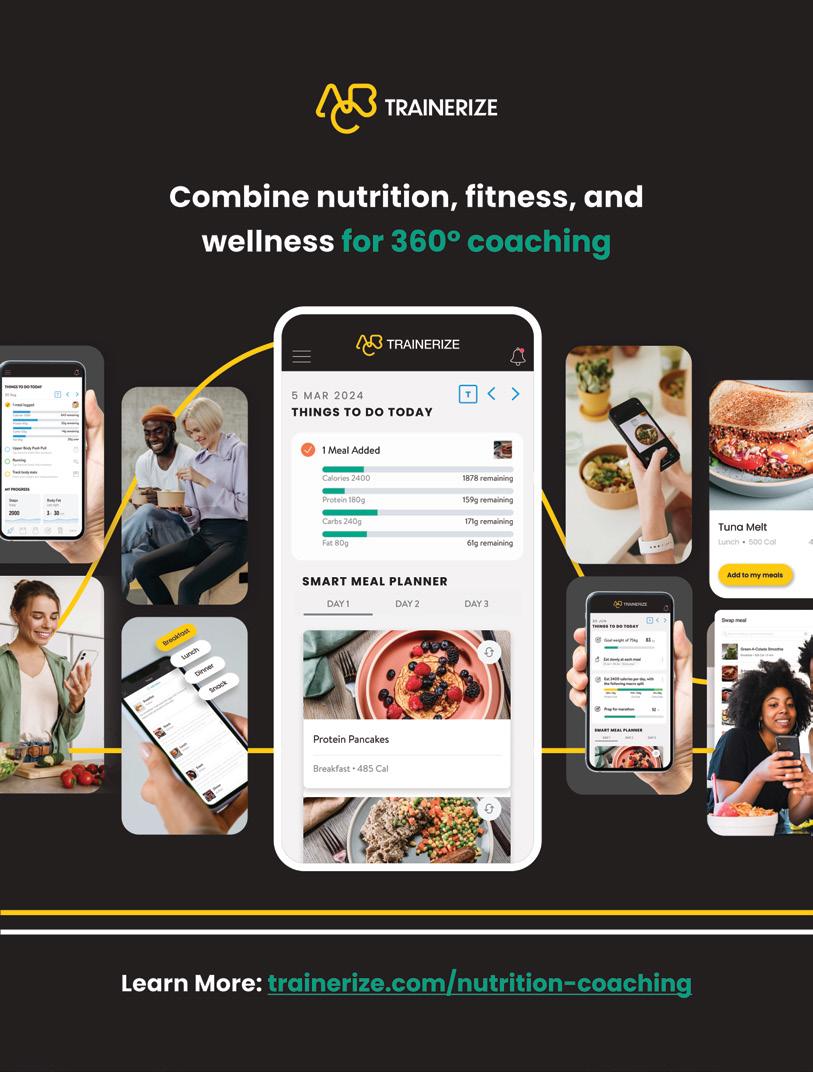

MAXIMIZE IMPACT BY CHALLENGING COGNITIVE LOAD WITH THESE SAMPLE EXERCISES
By Your Fitness Sisters (Janice Hutton, Libby Norris, and Michelle Kerr)
THERE IS A MASSIVE OPPORTUNITY TO WORK WITH OLDER ADULTS (50+) IN OUR INDUSTRY RIGHT NOW. IF YOU CHOOSE TO WORK WITH THIS POPULATION, TO BE SUCCESSFUL IT IS IMPORTANT TO UNDERSTAND THEIR NEEDS AND ABILITIES AS YOU PLAN WORKOUTS OR GROUP CLASSES.
Begin by shifting your language from ‘anti-aging’ to ‘longevity’ to help individuals embrace a positive mindset. Recognize that lifespan (living a long time) is an expected goal, but it is important to realize that health span (remaining free from chronic disease) is more valuable to an aging adult. For many, there is a gap of up to nine years where they experience an increasing burden of common diseases like diabetes, cardiovascular disease (high blood pressure, poor heart function), cancer (breast, prostate, skin), or autoimmune diseases (arthritis, inflammatory bowels, psoriasis). A critical aspect of health span is also promoting brain span, which includes maintaining good cognitive functions such as memory, information processing, ability to focus and concentrate, and learning new skills. Living to be 100 sounds great, but the gradual loss of mental abilities is not a desirable state as it puts enormous stress on the individual, their family members, care givers, and the medical system.
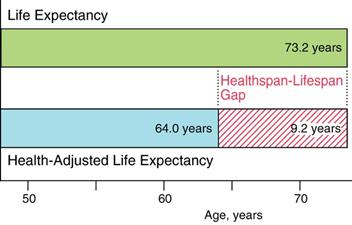
Source: nature.com/articles/s41536-021-00169-5
Research has shown us that being active, exercising regularly, being mobile, lifting weights, doing flexibility and balance training all help to boost health and help older adults thrive with age. Many fitness professionals focus on strength training or cardiovascular training to keep the aging body strong. To maximize our impact with older adults, can we also intentionally build brain health as well? Consider creating hybrid workouts that deliver mind and body challenges simultaneously.
As fitness professionals, we understand the principle of using progressive overload to promote adaptation and challenge the body to become stronger. To build muscular endurance, strength, and power we intentionally change the physical load by manipulating the amount of resistance,
movement speed, and repetition, or set range individuals perform. Can we challenge cognitive load in a similar way?
In physical load, we consider the amount and type of energy we use to perform a movement skill. Cognitive load is like physical load, where we consider the amount and type of memory resources (mental energy) we use to execute a new or old skill. Cognitive load theory was developed in the 1980s to support learners in an educational setting, but we can use this idea to help active agers boost their brain power while exercising.
There are three types of cognitive load that influence the exerciser:
Intrinsic Load = the complexity of new or novel skills to execute compared to prior knowledge
Germane Load = the organizing and processing of new information and connecting it to existing knowledge
Extraneous Load = distractions that disrupt the working memory from processing new information
Individuals can experience cognitive overload when the working memory resources are overwhelmed by the combination of Intrinsic + Germane + Extraneous Loads together and the result is poor or failed performance. The solution to cognitive overload is to decrease the intrinsic load (simplify the task) and / or decrease the extraneous load (reduce distractions and give more clear instructions).
When we increase movement complexity by linking upper body with lower body movements, we challenge mind –muscle coordination. If we change the movement tempo, add planes of motion, add new movement patterns, or add a balance challenge with a flood of sensory feedback, we challenge information processing speed. When we ask an individual to perform a new skill with an already practiced skill like a squat on a BOSU, we challenge memory and novelty to work together. This is an extremely exciting concept to consider when you are building workouts or classes. Developing exercises with a clear intention of appropriately challenging cognitive load along with physical load gives the active ager a massive advantage in boosting both health span and brain span.
Let us build strength training blocks that intentionally MIX physical and cognitive load. From a physical perspective, we will focus on the fundamental movement patterns that we know build a body that moves the way it was designed. Choose exercises that challenge Push, Pull, Hinge, Squat / Lunge, Loaded Carry, and Rotation / Counter Rotation. Choose the amount of resistance, the movement speed, repetition range, and the number of sets to impact the full spectrum of muscular endurance, strength, and power.
Now let us add on cognitive load to our exercise plan. Choose exercises that require movement complexity (link upper to lower body), a change in the movement direction (all three planes of motion), a new movement pattern (cross body), a mix up of the movement tempo (fast – slow), a unilateral motion, or include a balance challenge to push the boundaries of cognitive load. Be aware that cognitive overload = movement failure or poor performance, so progress slowly to keep the active ager successful, fully motivated, and engaged.
Block 1:
Let us focus on planes of motion and patterns. Complete eight reps of each exercise with an option to do one or two sets. View full video of exercises below.
https://youtu.be/8dviMGarvRs
Movement Equipment Basic Challenge
Lunge Hand Weights
Forward Lunge to Forward Raise
Forward Lunge with Forward Raise + Curtsy Lunge with Overhead Press
Hinge + Pull Hand Weights Hinge with 2 Arm Row Hinge to Row – R Arm, L Arm, 2 Arm, 2 Arm + Triceps
Rotate / Counter Rotate
Tubing Cross Body Low to High Chop
Balance No equipment Single Leg balance 4 counts – Rear
Leg Extension 4 counts – Single
Leg 4 counts –touch down 4 counts (repeat other leg)
Kickbacks x 4
Lateral Step to Low to High Chop
Single Leg balance 4 counts – Rear
Leg Extension 4 counts – Tree
Pose 4 counts – touch down 4 counts (repeat other leg)
Block 2:
Let us focus on tempo changes and unilateral load. Complete 12 reps of each exercise with an option to do one or two sets. View full video of exercises below.
https://youtu.be/mfe7Tsez-4U
Movement Equipment Basic Challenge
Squat Hand Weights
Squat to 2 Arm Curl - tempo 2:2, 3:1, 1:3 for 4 reps each
Push Tubing Alt Rear Lunge to 2 Arm Press - tempo 2:2, 3:1, 1:3 for 4 reps each
Loaded Carry Hand Weights Alt Forward Lunge with SA carry - tempo 2:2, 3:1, 1:3 for 2 reps each arm
Balance BOSU
Lateral Step to SL* Balancetempo 2:2, 3:1, 1:3 for 2 reps each leg
*Alt (alternate), SA (single arm), SL (single leg)
Squat to 2 Arm Curl to Alt SA* Overhead Press - tempo 2:2, 3:1, 1:3 for 4 reps each
Alt Rear Lunge to Alt SA Press - tempo 2:2, 3:1, 1:3 for 4 reps each
Alt Forward Lunge with SA carry to Forward raisetempo 2:2, 3:1, 1:3 for 2 reps each arm
Lateral Hop to SL Balancetempo 2:2, 3:1, 1:3 for 2 reps each leg
Our goal as fitness professionals is to help our active agers thrive through intentional exercise design. When we mix appropriate physical load with cognitive load, we amp up the mind-body challenge and help individuals age with both a strong mind and a strong body. The options are endless and so is the fun!
Libby Norris, Michelle Kerr and Janice Hutton are Your Fitness Sisters. They are passionate about fitness and leadership and have joined together to share trusted insights and abilities acquired over extensive years of diverse experience in the fitness industry. Their experience includes group fitness, group training, personal training, aqua fitness, fitness leadership, facility management, program creation and certification development along with presenting at national and international conferences for over three decades. They love working with industry professionals, fitness clubs, corporate fitness facilities, and municipal recreation centers to promote innovative programming and strong leadership skills that ultimately create a positive environment for participants to enjoy being active and fit.
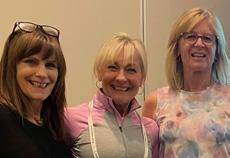




Skip the gimmicks and fads; learn the training principles that have provided results for decades.
$48.95 $34.27 MRAR30

Lose fat. Add muscle. Look great. No fads or diets are required—just hard work, sensible strategies, and science-based programming.
$45.95 $32.17 MRAR30
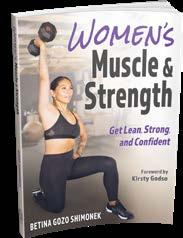
With over 100 exercises and 60 workouts, this is the definitive resource on metabolic training.
$41.95 $29.37 MRAR30




Learn how to create a long-term plan to help you maximize your recovery and feel your best.
$45.95 $32.17 MRAR30
This is a must-have workout companion to help you reach your fitness goals and reap the benefits of strength training through every phase of life.
$41.95 $29.37 MRAR30
Discover the pure power and aesthetic beauty of dance as you perfect your technique.
$45.95 $32.16 MRAR30



Par les « Fitness Sisters » (Janice Hutton, Libby Norris, et Michelle Kerr)
ACTUELLEMENT DANS NOTRE INDUSTRIE, IL EXISTE UNE OCCASION QU’IL NE VOUS FAUDRAIT PAS IGNORER : CELLE DE TRAVAILLER AVEC LES ADULTES DE 50 ANS ET PLUS. SI VOUS DÉCIDEZ DE TRAVAILLER AVEC CE GROUPE D’ÂGE, POUR RÉUSSIR, IL EST IMPORTANT DE BIEN COMPRENDRE CE DONT ILS ET ELLES ONT BESOIN ET CE QU’ILS ET ELLES SONT CAPABLES D’ACCOMPLIR LORS DE LA PLANIFICATION DE VOS ENTRAINEMENTS ET COURS DE GROUPE.
Espérance de vie en bonne santé et espérance de vie cognitive Commencez par modifier votre vocabulaire ; remplacez « lutte contre le vieillissement » par « longévité » pour les aider à adopter une attitude positive. Reconnaissez que la durée de vie (longévité) est un objectif bien établi, mais prenez également conscience que l’espérance de vie en bonne santé (rester à l’abri des maladies chroniques) est encore plus précieuse pour un.e adulte vieillissant.e.
Sur une période de près de neuf ans, plusieurs d’entre eux commenceront à ressentir le fardeau de maladies comme le diabète, les maladies coronariennes (hypertension, dysfonction cardiaque), le cancer (sein, prostate, peau), ou des maladies auto-immunes (arthrite, maladies inflammatoires de l’intestin, psoriasis).
Un aspect de l’espérance de vie en bonne santé qu’il ne faut pas négliger est la santé cognitive. La bonne santé cognitive inclut le maintien de bonnes fonctions cognitives comme la mémoire, le traitement de l’information, la capacité de se concentrer et d’apprendre de nouvelles compétences. De prime abord, vivre jusqu’à 100 ans semble formidable, mais la perte progressive d’aptitudes cognitives n’est pas souhaitable puisqu’elle impose un stress énorme sur l’individu, sa famille, ses soignants et le système de santé.

Source: nature.com/articles/s41536-021-00169-5
L’activité physique stimule l’espérance de vie en santé physique et cognitive
Les recherches démontrent qu’être physiquement actif, de faire de l’exercice régulièrement, d’être mobile, de soulever des poids, et d’effectuer des exercices de
flexibilité et d’équilibre contribuent à stimuler une bonne santé et à aider les personnes âgées à s’épanouir avec l’âge. Plusieurs professionnels du conditionnement physique ciblent l’entrainement musculaire ou cardiovasculaire pour maintenir un corps fort et en santé.
Afin de maximiser notre impact auprès des adultes de 50 ans et plus, pourrions-nous envisager de développer intentionnellement leur santé cognitive également ? Pensez à créer des entrainements hybrides qui pourraient stimuler à la fois leur esprit et leur corps.
Charge physique contre charge cognitive À titre de professionnels du conditionnement physique, nous comprenons le principe d’utiliser une surcharge progressive pour favoriser l’adaptation et stimuler le corps à devenir plus fort. Pour développer l’endurance, la force, et la puissance musculaire, nous modifions intentionnellement la charge physique en manipulant la résistance, la vitesse du mouvement, et le nombre de répétitions, ou l’étendue des séries effectuées par les individus. Pourrions-nous stimuler la charge cognitive de façon similaire ?
Qu’est-ce que la charge cognitive ?
Dans la charge physique, nous tenons en compte la quantité et le type d’énergies utilisées pour effectuer un mouvement. La charge cognitive est semblable à la charge physique, alors que nous considérons la quantité et le type de ressources mentales utilisées pour exécuter une nouvelle ou une ancienne compétence. Dans les années 80, la théorie de la charge cognitive a d’abord été développée pour appuyer les élèves dans un environnement scolaire, mais nous constatons que nous pouvons nous en servir pour aider les adultes actifs à stimuler leur puissance cognitive tout en faisant de l’exercice.
Trois types de charge cognitive influenceront le ou la participante :
Charge cognitive intrinsèque = La complexité de nouvelles compétences à exécuter versus celles que nous connaissons déjà.
Charge cognitive pertinente = l’organisation et le traitement de nouvelles informations et leur mise en relation avec les connaissances existantes.
Charge cognitive extrinsèque = les distractions qui empêchent la mémoire de travail de traiter de nouvelles informations.
Les individus peuvent éprouver une surcharge cognitive lorsque les ressources de la mémoire de travail sont submergées par une combinaison de charges intrinsèque, pertinente, et extrinsèque, entrainant une pauvre performance ou un échec. La solution à la surcharge cognitive est de diminuer la charge intrinsèque (simplifier la tâche) et/ou la charge extrinsèque (réduire les distractions et donner des directives plus claires).
Comment pouvons-nous tirer parti de la charge cognitive ?
Lorsque nous augmentons la complexité d’un mouvement en associant le haut du corps à des mouvements du bas du corps, nous stimulons la coordination cognitivo-musculaire. Si nous changeons le tempo du mouvement, ajoutons des plans de mouvement, ajoutons de nouveaux schémas de mouvements, ou que nous ajoutons un défi d’équilibre avec un flot de rétroactions sensorielles, nous mettons à l’épreuve la vitesse de traitement de l’information. Lorsque nous demandons à un individu d’effectuer une nouvelle compétence conjointement à une déjà acquise comme un squat sur un BOSU, nous mettons au défi les fonctions cognitives de combiner une habileté connue à une nouvelle. Voilà un concept très excitant à prendre en compte lorsque vous élaborez des entrainements ou des classes. Développer des exercices avec l’intention claire de solliciter adéquatement les charges cognitive et physique confère à l’adulte actif un avantage considérable pour stimuler sa longévité active et cognitive.
Mettre la théorie en pratique
Élaborons des blocs d’entrainements musculaires qui COMBINENT intentionnellement les charges physique et cognitive. D’un point de vue physique, nous ciblerons les schémas de mouvements fondamentaux que nous savons contribuer à développer un corps qui bouge comme il a été conçu afin de le faire. Choisissez des exercices qui seront physiquement exigeants : tirer, pousser, se pencher, s’accroupir (squat), faire des fentes, porter une charge, faire des rotations et des contrerotations. Choisissez la charge de résistance, la vitesse du mouvement, le nombre de répétitions et de séries qui auront un effet sur l’ensemble du spectre de l’endurance, de la force et de la puissance.
Maintenant, ajoutons une charge cognitive à ce plan. Choisissez des exercices qui ajoutent une complexité au mouvement (associez le haut du corps à des mouvements du bas du corps), un changement de direction (utilisez les trois plans de mouvement), un nouveau schéma de mouvement (mouvement croisé), un mélange de tempo (alternez entre rapide et lent), un mouvement unilatéral, ou ajoutez un défi d’équilibre pour repousser les limites de la charge cognitive. Soyez avisés que la surcharge cognitive est équivalente à l’échec du mouvement ou à une pauvre performance, le progrès doit être lent pour maintenir la motivation et l’engagement de l’adulte actif et assurer sa réussite.
Bloc 1 :
Ciblons d’abord les plans de mouvements et les schémas. Effectuer huit répétitions de chaque exercice avec l’option d’exécuter une ou deux séries. Voir la vidéo pour visionner tous les exercices.
Mouvement Équipement Mouvement de base Défi
Fente Poids libres Fentes avant avec élévations avant des bras
Flexions de la hanche + tirades
Rotation/ contrerotation
Poids libres Flexions de la hanche combinées à tirades et extensions arrière des bras
Fentes avant avec élévations avant des bras + fentes croisées combinées à développés des épaules
Flexions de la hanche avec tirades – tirades à 1 bras (alterner bras D, bras G (2x)), tirades à 2 bras (2x) ; + combiner tirades et extensions arrière du triceps 2 bras (1 x)
Tube Fentes croisées à coups de pied élevés avant
Équilibre Aucun équipement
Pas latéraux à coup de pied avant bas
Sur une jambe, se tenir en équilibre sur 4 temps – Effectuer une extension arrière de la jambe sur 4 temps – Toucher au sol avec une main sur 4 temps (répéter sur l’autre jambe)
Sur une jambe, se tenir en équilibre sur 4 temps – Effectuer une extension arrière de la jambe sur 4 temps – Pose de l’arbre sur 4 temps – Toucher au sol avec une main sur 4 temps (répéter sur l’autre jambe)
Bloc 2 :
Dans le bloc 2, nous ciblerons les changements de tempo et les charges unilatérales. Effectuer douze répétitions de chaque exercice avec l’option d’exécuter une ou deux séries. Voir la vidéo pour visionner tous les exercices.

Résumé
Mouvement Équipement Mouvement de base Défi
Fente Poids libres Accroupissements (squats) combinés à 2 flexions des bras - tempo 2:2, 3:1, 1:3 ; 4 répétitions chaque
Accroupissements (squats) combinés à 2 flexions des bras en alternant les bras, développés des épaulestempo 2:2, 3:1, 1:3 ; 4 répétitions chaque
À titre de professionnels du conditionnement physique, notre objectif est d’aider nos adultes vieillissants actifs à continuer de s’épanouir grâce à des exercices réfléchis et conçus en ce sens. Lorsque nous combinons des charges physiques appropriées à des charges cognitives, nous stimulons les fonctions cognitivomusculaires et aidons les individus à vieillir avec des capacités physiques et cognitives fortes. Les options sont infinies, le plaisir aussi !
Flexions de la hanche + tirades
Rotation/contre-rotation
Tube Fentes arrière alternées et extensions avant des bras alternées - tempo 2:2, 3:1, 1:3 ; 4 répétitions chaque
Poids libres Fentes avant alternées, en alternant poids libre G-D (côté opposé) - tempo 2:2, 3:1, 1:3 ; 2 répétitions chaque bras
Équilibre BOSU Pas de côté à équilibre sur une jambe - tempo 2:2, 3 : 1,1 : 3 ; 2 répétitions chaque jambe
Fentes arrière alternées et extensions avant des bras alternéestempo 2:2, 3:1, 1:3 ; 4 répétitions chaque
Fentes avant alternées combinées à élévations avant des bras avec poids libre G-D (côté opposé) - tempo 2:2, 3:1, 1:3 ; 2 répétitions chaque bras
Saut latéral à équilibre sur une jambetempo 2:2, 3:1, 1:3 ; 2 répétitions chaque jambe

Nous sommes heureuses de nous présenter Libby Norris, Michelle Kerr et Janice Hutton, ensemble, nous sommes les « Fitness Sisters ». Nous sommes des passionnées du conditionnement physique et du leadership et nous nous sommes réunies pour partager les connaissances et les compétences acquises au cours de nombreuses années d’expérience au sein de l’industrie du conditionnement physique. Nos expériences respectives incluent les cours de groupe, l’entrainement en groupe, l’entrainement personnel, l’aquaforme, le leadership en conditionnement physique, la gestion d’établissement, la création de programmes, et le l’élaboration de certifications de même que des allocutions dans le cadre de conférences nationales et internationales, et ce, depuis plus de trois décennies. Nous adorons travailler avec les professionnels de notre industrie, les centres d’entrainement, les installations en entreprise, et les centres de loisirs municipaux pour promouvoir des programmes novateurs et encourager le leadership qui seront ultimement la fondation d’un environnement positif au sein duquel chaque participant.e aura du plaisir à être actif et active et en forme !


FIRST, ADVANCED ASANA PRACTICE IS NOT ADVANCED YOGA, BUT RATHER A MORE COMPLEX PHYSICAL PRACTICE TO CHALLENGE OUR STRENGTH, STAMINA, AND OUR ABILITY TO BE STILL IN MIND AND BODY.
With yoga, the goal is yoga itself. Working in the fitness industry, that might hurt our brain a little! Everything we do, from increasing our weight in strength training, pushing ourselves further and faster in our cardio, or excelling in competition and sport, is based on advancing our training. There is a clear destination or goal, and that is what we strive to achieve.
However, yoga is a state of being. It is the moment that our mind is clear, the cluttered thoughts (citta vritti) have dissolved, and we feel most connected to ourselves. That is the definition of yoga provided to us from Patanjali, the ancient scholar and author of the Sutras of Patanjali, a revered book on yoga philosophy. To become advanced in yoga is the ability to hold the state of yoga, citta vritti nirodaha, for longer durations. We get there through continued practice of all eight limbs of yoga.
Yamas - social ethics, how we interact with each other
Niyamas - personal ethics, how we treat ourselves
Asana - postures
Pranayama - breath work
Pratyahara - withdrawal of the senses
Dharana - concentration
Dyana - meditative mind (cannot be taught)
Samadhi - bliss, or unity consciousness
When we first start to practice yoga, what one finds advanced, or challenging, is often quite different from another. I think of ex-dancers, like me, where the flexibility of the postures came easily for me when I first started. I could do more of the extreme postures in my twenties than I can now, but without question, after 20 years of studying yoga and meditating, my practice has certainly advanced
since then. As we step past what most consider yoga, aka the poses, and more into the meditation aspects, this is where the challenge begins.
For the same reason someone with a sedentary lifestyle needs more physical activity to improve their health, those of us who get stuck in the hamster wheel of thought, or experience anxiety, need to practice stillness within. If you have ever tried meditation and thought it was too difficult, that is the first step to understanding the benefits a regular practice would bring. In the same way that someone who struggles to climb stairs has little interest in exercise, we know that is exactly what they need to do.
THE MORE WORRIED WE ARE ABOUT ACHIEVING THE POSES, THE FURTHER AWAY THEY BECOME.
That said, just like pushing ourselves a little extra during our weight training sessions, we should practice postures that challenge us. When we go through the same postures and sequences all the time, we start to get complacent in our practice. Where certain postures once held our full attention, we now find our mind drifting off to other things outside the room. The challenge of these postures helps us stay present and focused. Remember, we call this yoga practice because asana and the meditative mind require practice. The more worried we are about achieving the poses, the further away they become. We should always be approaching asana with curiosity and even a sense of playfulness.
Let us consider what the purpose of bringing these poses into our practice and teachings is for. For those who are quite athletic or have been practicing for a long time, the challenge of these poses is needed - and NOT just from a physical standpoint. We need to remember what it feels like to be “new” again, to experience frustration or disappointment while struggling with a posture, to go through the
process required to get passed this, to quiet the negative voice in our head and come back to what the experience of yoga is. If this is not for joy, then what is the point?
Each time you practice asana, please keep the following in mind:
1. Our breath should always be our number one indicator of how we are doing in each pose. If our breath is laboured or short, we are in too deep. Likewise, if we are in an active pose and our breath is too easy, we can go deeper. Always refer to your breath inside the pose and through your transitions.
2. When the bandhas (locks) are engaged, the rest of the body will find its way.
3. From the Sutras of Patanjali 2:46, “Sthira Sukham Asanam” or “Asana is a steady, comfortable posture.” (Swami Satchidananda). Within every pose and through every transition this should always be considered.
Remember, the goal of yoga is yoga itself. A state of being. If you are pursuing the dream of becoming an “Advanced Yogi” you will be like a dog chasing its own tail, simply going around and around until you are tired and dizzy. Rather, think about advancing your studies and committing to regular daily practice. This is not something to master and then move on, but a lifelong journey of ebbs and flows. What you achieve is peace and the ability to come back more easily to that peaceful state. What a powerful gift this practice is!



While physical fitness is often the primary focus, the significance of mental health in achieving sustainable physical change must not be overlooked. As a therapist, I explore the realms of psychology, trauma, limiting beliefs, and how individuals perceive themselves and the world around them. I recognize the vital connection between mental and physical wellbeing when it comes to achieving positive outcomes for my clients. Our clients can only ever achieve what they can truly believe is possible for them. Trauma, low self-esteem and confidence, body dysmorphia, disorderly eating, core values, choice of role models all directly affect the actions your clients will or will not take.
Central to comprehending the importance of mental health in personal training is recognizing the inextricable connection of the mind and body. Numerous studies have established the profound effects of mental well-being on physical health. Psychological stress, for instance, can manifest physically as disruptions in sleep patterns, weakened immune system, or even chronic pain and disorderly eating. Conversely, individuals possessing positive mental states and healthy overall well-being are more likely to engage in regular exercise, adhere to balanced diets, and exhibit higher levels of motivation and perseverance.
Motivating clients to initiate and maintain a fitness regimen is a fundamental aspect of personal training. However, without addressing potential psychological barriers, even the most well-intentioned approaches may fall short. Understanding client psychology empowers personal trainers to craft tailored strategies that resonate with individual motivations and needs. By promoting a healthy mindset, trainers can foster self-efficacy, thereby encouraging clients to develop intrinsic motivation and make long-term commitments toward their physical transformation. Therapists in the mental health space can contribute to goal setting by incorporating mental health considerations, healing past trauma, upgrading limiting beliefs, and building more confidence and possibility within the client’s psychology, supporting clients in establishing realistic and achievable objectives.
The pursuit of physical change can be emotionally challenging for clients. Feelings of self-doubt, body image concerns, past failures, stressors from various other life domains, and limiting beliefs that can
sometimes sound like this...
“I’ve always been an all or nothing person.”
“I don’t have time.”
“I’ve always been chunky, it’s my genetics.”
“I’m a perfectionist.”
“It’s always been hard for me to lose weight (gain muscle etc.).”
“I’m just addicted to sugar.”
‘I can’t live without chocolate.”
“I love wine too much.”
“I’m just not a morning person.”
...and so on (which I am sure you have all heard over time), can create emotional barriers to making progress towards physical change. These beliefs and thought patterns can hold clients back from taking action, staying consistent, and ultimately achieving their goals.
Self-doubt can make clients question their abilities and undermine their confidence to make the necessary changes.
Thinking in extremes, such as believing they are an “all or nothing” person, can set unrealistic expectations and lead to feelings of failure if they are not able to adhere perfectly to a plan. This kind of mindset can discourage clients from even trying because they fear they will not be able to meet their own high expectations.
Limiting beliefs about time can make clients feel overwhelmed and believe they do not have enough time to dedicate to their physical change. This can lead to procrastination or giving up altogether before even starting.
Labeling themselves as a perfectionist can also hinder progress as clients may become fixated on doing everything perfectly, leading to “paralysis by analysis” and an inability to take action. This can create a cycle of constantly setting unrealistically high standards and feeling disappointed when they are not met.
Beliefs about the difficulty of weight
loss, gaining muscle, or making other physical changes can become self-fulfilling prophecies. If someone believes it is inherently difficult for them to achieve their goals, they may not fully commit to the process or give up easily when faced with challenges.
Addictions to certain foods or habits, like sugar, chocolate, or wine, can present additional emotional challenges. These cravings and dependencies can make it harder for clients to make healthier choices and stick to a plan that aligns with their physical goals. Overcoming these addictions requires a combination of physical and emotional strength. Most disorderly eating/addictions are developed from suppressed emotions.
Here are four revealing questions personal trainers can ask their clients to figure out clients’ limiting self beliefs:
PSYCHOLOGICAL STRESS ... CAN MANIFEST PHYSICALLY AS DISRUPTIONS IN SLEEP PATTERNS, WEAKENED IMMUNE SYSTEM, OR EVEN CHRONIC PAIN AND DISORDERLY EATING.
1. What do you believe is preventing you from reaching your health/fitness goals?
This question allows the personal trainer to understand the client’s perception of their limitations. It could reveal beliefs such as lack of time, genetics, or past failures that may be holding them back.
• A follow up question to their answer(s): How much is it costing you by continually believing that?
2. How do you see yourself in relation to your desired health/ fitness level?
This question aims to uncover any negative self-perceptions or
beliefs that might be hindering the client’s progress. They may see themselves as undeserving or incapable of achieving their goals, which could be a limiting belief that needs to be addressed.
3. What past experiences or influences have shaped your current beliefs about health/ fitness and exercise?
Exploring the client’s background and past experiences in relation to fitness can unveil any limiting beliefs that have been internalized. Traumatic events, negative feedback, or societal pressures may have contributed to self-doubt or fear of failure, which need to be understood and addressed by the trainer.
• If the answer is negative, follow on with this question: If you erased those experiences/ influences, what could your new beliefs be?
The connection between mental health and physical change cannot be understated. As personal trainers, it is our responsibility to recognize and address the psychological barriers that can hinder our clients’ progress. By asking revealing questions and uncovering limiting self-beliefs, we can guide our clients towards transforming their self-perception and mindset, ultimately leading to greater commitment, consistency, and results. Remember, it is never too late for clients to develop new beliefs and achieve the physical and mental wellbeing they desire. Together, we can shape their future, one empowering belief at a time.

Jen Rieder is a highly skilled therapist and mentor based in New Zealand. With her extensive knowledge and expertise in the fields of neuroplasticity, NLP, Time Line TherapyTM, hypnosis, and psychology, she offers proven transformational methods that bring about lasting change.






As low as

Hear from dynamic speakers as they unpack the intricacies of holistic well-being and offer valuable insights tailored to women at every stage of life.
Seven sessions
EARN 2 CECs One-Day $90

As low as BUNDLE $166
EARN 4 CECs
Aspire to be your best self and register for this transformative experience!